-
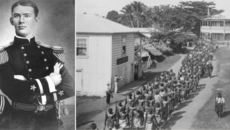
TALES OF TIME: John Monaghan a Hero or Foe?
5,408 miles away from Samoa on the other side of the world lies a statue of military officer John R. Monaghan. A huge monument to honour a man born in Washington and killed in Vailele. Monaghan was sent to Samoa during the second Samoa Civil War in 1899. What history books will tell you was a war of “Samoans against Samoans”, but what locals would remind you was a colonial tug of war to see who could annex these Pacific islands. This is where officers like Monaghan come in, him and his men were sent to Samoa with the purpose of winning the islands for the countries they served. {{28341}} In 1899, Samoa was a warzone as it had been previously during the First Samoan Civil War. On the island of Upolu villages along the coast of Apia to Vailele were filled with armed men given weapons by Germany, USA and Great Britain to fight for the ownership of the nation. The two Samoan chiefs who lead opposite side of the battle were Malietoa Tanumafili and Mata’afa Iosefa. The British and Americans supported and armed the side of Malietoa while the Germans did the same for Mata’afa. {{28343}} Loyal to the US Military Monaghan’s time in Samoa was not his first entanglement in colonial looting and backwater bullying. He was in the troop that intimidated the people of Nicaragua, when America was trying to build a canal to link the seas. The year before he arrived in Samoa he participated in the ceremonies marking the forced annexation of Hawaii into the American domain. By the time he reached the shores of Apia he was already experienced in the colonial affairs of his country and the work it took to colonize an island. {{28370}} On the first day of April 1899 the two opposing sides of the civil war were prepared for battle. Mata’afa’s forces for a while were tucked away in Vailele where Malietoa’s supporters together with the US troops were heading to attack. In the heat of the collision of both parties John R. Monaghan found himself in a precarious situation when his force was ambushed. {{28350}} When his unit's leader was wounded, Ensign Monaghan seized a rifle and attempted to rescue the injured officer but failed. Monaghan was killed on this day along with hundreds of other Samoan caught in the cross-fire. {{28348}} The American officer was not the only man to die that day fighting for their country. The American, German and British men who were sent to Samoa to fight chose to do so, while majority of Samoans who died that same day were given no choice but to face the battle that was at their doorstep. {{28362}} 7 years after Monaghans death the statue commemorating him was raised in downtown Spokane, Washington. The inscription on the statue reads: "During the retreat of the allied forces from the deadly fire and overwhelming number of the savage foe, he alone stood the fearful onslaught and sacrificed his life defending a wounded comrade Lieutenant Philip V. Lansdale United States Navy". {{28368}} Alongside the inscription is a carved image of an inaccurate retelling of Monaghan’s death, where Samoans are painted to be “savages” with bows and arrows. The monument still stands in Spokane today where many Samoans living in Washington are reminded of the dark history of colonial powers pitting Samoans against each other and aiding war with their imported weapons. {{28366}} The words “savage foe” and images of “uncivilised” Samoans that the monument displays also further haunts the Pacific Island community as they have to be reminded of the racism that existed and continues to exist against them. Today the “Native Hawaiian Pacific Islander Club” at Eastern Washington University are part of the young people rallying to try and remove the John R. Monaghan. The group feel that the racist connotations of the statue is reason enough to have it removed and show the Pacific Island community in Washington that they are valued more than an old monument honouring a man who was sent to the islands to fight and kill locals. {{28364}} The month of April 123 years ago was one of great importance. We remember all the Samoans who were killed in the battle of Vailele and the last civil war of their island home. Although the hundreds of Samoans who died do not have huge monuments to remember their lives, they live on in the fight of their young people in places like Washington who remember their legacies by questioning the honouring of a man who did not honour them.
-
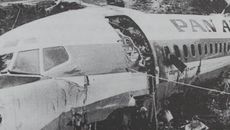
TALES OF TIME: The Pan Am Plane Crash of 1974, Pago Pago American Samoa
The 30th of January marks the anniversary of the Pan American Flight 806 crash in Pago Pago during the 70s. Although decades have passed, family and friends of those who perished still mourn today as a day of grief that took the lives of 97 people onboard the flight. Pan Am Flight 806 was an international scheduled flight from Auckland, to California, with intermediate stops at Pago Pago, American Samoa and Honolulu. The flight was a popular island hopping and connection flight between the Pacific and the US during the golden years of Pan America simply known as “Pan Am’. {{27493}} On January 30, 1974, the Boeing 707 Clipper Radiant crashed on approach to Pago Pago International Airport, killing 87 passengers and ten crew members. Families all over New Zealand, America and Samoa mourned those lost in the crash of a flight that was expected to safely land carrying the loved ones of people waiting in all three countries. In 1970s, after what was described as a comprehensive investigation the National Transportation Safety Board (NTSB) determined the probable cause of the accident was the flight crew's tardy identification of microburst-induced wind shear. Listed in the report was other possible contributing factors including poor visibility and a lack of altitude and airspeed callouts by the aircrew. At 23:11, Flight 806 contacted Pago Pago Approach Control and reported its position 160 miles south of the Pago Pago airport. {{27491}} The next 20 minutes of the radio conversation between the flight crew and the controller was recorded. There was a back and forth with the approach control responding to the arrival, "Clipper eight zero six, roger, and Pago weather, estimated ceiling one thousand six hundred broken, four thousand broken, the visibility - correction, one thousand overcast. The visibility one zero, light rain shower, temperature seven eight, wind three five zero degrees, one five, and altimeter's two nine eight five." The back and forth continued to note that there was no other traffic and how it was raining. {{27495}} On the flight deck the windshield wipers were turned on and the flaps were set at the 50° position, which completed the checklists for landing. At 23:40:22, the first officer stated, "You're a little high." The radio altimeter warning tone then sounded twice.\ He reported the field in sight and said that they were at 140 kts. At 23:40, the aircraft crashed into trees at an elevation of 113 feet, and about 3,865 feet short of the runway threshold. The first impact with the ground was about 236 feet farther along the crash path. The aircraft continued through the jungle vegetation, struck a 3-foot-high lava rock wall, and stopped about 3,090 feet from the runway threshold. Although the flight crash report includes the transcription of the last conversation between the flight crew and the Pago Pago operators, many families still hold unanswered questions on what happened. The most common questions is “How could a trained staff on a large corporate airline flight fail to carry out their due diligence?”. {{27497}} Of the 101 occupants of the aircraft, 9 passengers and 1 crew member survived the crash and fire that followed the crash. One passenger passed the next day. A crew member and three passengers passed 3 days after the accident. The last causality of the flight passed away 9 days following due to injuries brought on by the crash. {{27499}} The Pan Am 806 will mark its 50th anniversary in 2 years. 5 decades later generations of the families impacted still mourn what could’ve been and the tragedy of this dark day. Family members such as Sopo Su’a who lost her grandmother Telinga Tangatauli on the flight. Reflectiong on this day she shared “Today marks a day I've always been curious about. My nana Telinga Tangatauli died on the Pan Am Aeroplane crash 30th Jan 1974 in American Samoa. One story mum shared was that nana took off her wedding ring and offered to give it to my mum and mum said no that's you and dads wedding ring. My granddad was waiting for her to arrive in Samoa. Sadly, she never arrived”. Sopo joins family and friends of the victims of the Pam Am 806 crash all remembering their loved ones today. - Written by Brianna Fruean Public Interest Journalism funded by NZ On Air
-
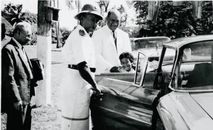
Tales of Time - Mata'afa Faumuina Fiame Mulinu'u II
* Cover image - a young Fiame Naomi Mata'afa with her father Mata'afa Faumuina Mulinu'u II Fiame Mataʻafa Faumuina Mulinuʻu II CBE was born on the 5th August 1921, the son of Mata'afa Faumuina Fiame Mulinuu I, a leader of Samoa's self-determination movement, known as the Mau. He did his schooling at the Marist Brothers school in Apia and later married Laulu Fetauimalemau Mata'afa who at the time was a teacher. In 1970, she was appointed the first Pro-Chancellor of the University of the South Pacific (U.S.P) until 1976 and received an Honorary Doctor of Laws degree from the University in 2004. Laulu was appointed Consul General to New Zealand before being promoted to High Commissioner to New Zealand in 1993. She was well known for her roles in enhancing the status of women, for which she was awarded the Order of Tiafau in 1993. {{25161}} Mata'afa was bestowed with the Fiame title in 1948 and also became a Faumuina. When Mat'afa Faumuina Fiame Mulinuu I passed away the same year, he took the Mata'afa title, one of the four Tama Aiga chiefly titles. He was also a descendant from the Malietoa family. In the early 1950'a he showed little interest in politics but showed a keen interest in the youth of Samoa and became President of the Samoan Branch of the Boys’ Brigade. He was also a Senior Grade rugby player. After it was agreed in the 1954 Constitutional Convention that two of the four paramount chiefs, Tupua Tamasese Meaʻole and Malietoa Tanumafili II, should be made joint heads of state for life, he announced that he would withdraw from public life. However, he later backed down and contested the 1957 elections to the Legislative Assembly, winning the Lotofaga seat. Following these elections he was appointed to Executive Council as Minster of Agriculture under the then Leader of Government Business - Eugene Paul. His only daughter Fiame Naomi Mata'afa was born on the 29th of April 1957. {{25159}} In 1959 he became the first Prime Minister of Samoa. Prior to the election of Prime Minister in 1959, the Samoan members had already decided that their first Prime Minister would be a full Samoan, and Mata’afa was their choice. Eugene Paul and Tualaulelei Mauri were defeated. Mata'afa was one of the framers of the Constitution of Samoa and was honoured with a Commander of The Most Excellent Order of the British Empire in 1960 (CBE) Mata'afa was re-elected Prime Minister following the 1961 elections, leading the country to independence in 1962. {{25156}} He was re-elected again following elections in 1964 and 1967. However, after the 1970 elections, he was defeated by Tupua Tamasese Lealofi IV by 25 votes to 20 in the third round of voting. It was reported that he would have probably won in the second round (which was tied at 23 votes each) if one of his supporters, To'omata Lilomaiava Tua, had not died the previous week. Following the 1973 elections, Mata'afa returned as Prime Minister, defeating Lealofi and Tupuola Efi in the first round of voting. {{25163}} He served as Prime Minister until his death in 1975. Fiame's mother Laulu Fetauimalemau Mata'afa won the subsequent by-election for Mata'afa's Lotofaga seat when he passed away, Mata'afa Faumuina Fiame Mulinu'u II died on the 20th of May 1975. His only daughter Naomi was just 18 years old at the time and was then bestowed with the Fiame title. She followed both her parents footsetps into politics taking the Lotofaga seat as a HRPP member, which had been previously held by her mother. She became the first female Cabinet Minister in Samoa when she took up the role of Minister of Education Sports and Culture. Years later in 2016 she became Samoa’s first female Deputy Prime Minister 100 years after Mata'afa was born and 46 years after his death, his daughter Fiame Naomi Mata'afa would become Samoa's first female Prime Minister. {{25157}}
-
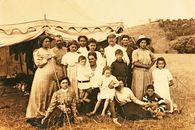
Tales of Time - The Kronfeld Family
The story of the iconic family known for their great hospitality, who hosted High-Chiefs and Queens. The Kronfelds were a Samoan-German family who lived in Auckland from 1890. They were known for their warm hospitality and the home away from home that they provided. Old stories of the past recall how they offered a safe, family-focused centre of hospitality for people passing through from the islands when there were very few Samoans living in New Zealand. Nowadays you couldn't find an island household in New Zealand that didn't have family and friends from the islands passing through at a point in time, but back then it was only the Kronfelds and they started a legacy of island hospitality in Aotearoa that continues today. {{23131}} Their large home in Eden Crescent, Central Auckland saw lots of visitors and was chronicled to never have a dull moment. ‘Oli-Ula’ was the name of their lively home, named after a sweet perfumed flower in Samoa. This sweet perfumed flower brought in many guests. Multiple guests stayed at Oli-Ula during their years at school in New Zealand. Guests included the then future Queen Salote Tupou of Tonga, and children of Samoa’s High-Chief Tuimaleali’ifano Si’u, one of the four Tama-a-aiga. {{23135}} With great visitors came even greater gifts. The Kronfeld Family housed many precious gems from across the Pacific ocean, given as tokens of appreciation for their hospitality. Queen Salote gifted the family an intricate ie toga (finely woven mat) to give thanks for hosting her in Auckland between 1910-1913. While Ali’i Sili (High Chief), Tupua Malietoa To'oa Mata'afa Iosefo gifted the family a large bronzed kava bowl. These items were amongst countless other treasures and taonga gifted to the Kronfelds. {{23138}} The Matriarch of this family was Mrs. Louisa Kronfeld. Her father was Portuguese sailor Augustine Silveira (also da Silva/Silva) and her mother Mele Fiame of Lotofaga, Falealili, Upolu. Louisa’s husband was German trader Gustav Kronfeld. They spent some years in Tonga before bringing their family to Auckland and establishing their own highly successful company of Pacific import-export. {{23142}} The Kronfelds were a successful family thanks to Gustav’s lucrative business. This financial security gave the family freedom to host generously and rub-shoulders with Auckland's elite. They were the original island socialites in Auckland. Business, life, and society were smooth sailing for the family until Mr. Kronfeld crossed an uncontrollable rocky road. Despite being a naturalised British subject, Gustav was confined as a prisoner for political reasons during the First World War in response to anti-German hysteria which swept New Zealand. He was held captive on Motuihe Island Internment Camp. His several years of captivity, accompanied by the breaking up of his trading relationships after he was interned, ruined his business. {{23151}} Although their trade business ended, their legacy continued. Many of the children and grandchildren continued to stay and work in Aotearoa. With each generation adding more branches to the Kronfeld family tree. The Kronfelds are still present around Auckland today. Great-great-granddaughter Emily Parr being one amongst the family still here. She said her ancestors' warm and familial hospitality helped countless travelers, and established Pacific Island roots in Auckland, at a time when very few Samoans were in New Zealand. Emily recently spoke to the public about her ancestors' house Oli-Ula saying “It was a beautiful big villa in Eden Crescent that he had built himself, and it had a full concert grand piano in the lounge, beautiful furniture and lots of treasures and taonga,”. Memories of Oli-Ula, the guests, the parties, the gifts, and much more are still being kept alive by descendants of the Kronfeld line. {{23153}} Louisa and Gustav Kronfelds descendants have continued to make a significant contribution to New Zealand in every facet of life, from sports to academia, clergy, art, education, and the military. They still remain a large part of Auckland’s fabric today, almost 150 years after Gustav and Louisa arrived. The Kronfeld family are currently a part of the Tāmaki Herenga Waka: Stories of Auckland exhibit at the Auckland War Memorial Museum in Parnell. The exhibit displays deeper details on the Kronfeld family and items that were gifted to the family, including the bronze kava bowl and Queen Salotes ie toga. The display is open to the public and you can go discover more about this iconic family there.
-
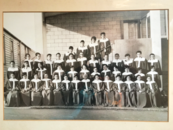
TALES OF TIME - PIC CHURCH GOWN OF CHOIR MISTRESS EPI PHETHEAN
By Aaron Taouma Objects inspire a sense of connection between time and space. Museum’s bring together and present such objects reminding us who we are and were as a collective over time. A jacket may represent an entire political movement (such as the Polynesian Panthers) and a Bill Sevesi steel guitar and aloha shirt may simultaneously represent the life of a musical legend and the hopes and dreams of a generation - sung and played out in music. {{21683}} Auckland Museum’s new permanent gallery - ‘Tāmaki Herenga Waka: Stories of Auckland’ – presents “our stories” through such significant objects. Here, you’ll find the items mentioned above as well as a crimson church gown worn by the late P.I.C. Youth Choir Mistress Mrs. Epi Phethean (nee Enari). The gown is dated 1966 (Tina Wichman) and is a material representation of what is one of the most significant connectors of Pacific stories in Aotearoa. {{21685}} The P.I.C. (Pacific Island Church or P.I.C.C. - Pacific Island Congregational Church), was established in 1948 in Ponsonby and led by Reverend Robert Challis, Reverend Tariu Teaia and Reverend Leuatea Sio. It became not only the first port of call for many new island immigrants to the country but also the spiritual centre of a combined Pacific village – bringing together Sāmoan, Cook Island (Kuki Airani), Niuean and Tongan congregations under one roof. In 1962 it was established at 2 Edinburgh St; Newton, off Karangahape Rd; and in 1970 the church merged with the Presbyterian Church Aotearoa NZ and became known as the P.I.P.C. (Pacific Island Presbyterian Church). It is not only the first Pacific church of Aotearoa but also home to many families. {{21687}} Reverend Sio in his time leading the church (over some 60 years) became known as ‘the father of Pacific Island communities in Aoteraoa’ and in a Facebook remark his daughter Rosalina Sio says; "P.I.C. Newton will always be our home base no matter where we are or will be during this lifetime. Out of Newton we have so many leaders of different churches, community groups, even MPs...So proud of being raised at Newton by our parents.” The gown represents the significance of this Pacific People’s home over the years but also is of a particular time in our histories when the church was still young and full of the energy of newly arrived families and an emerging first generation of New Zealand born Pacific Islanders. This new generation were pioneers of their time. Many had been part of the choir led by Mrs. Epi Phethean; such as the iconic singing trio ‘The Yandall Sisters’ and operatic star Iosefa Enari (Epi’s nephew). {{21699}} Dr Melani Anae is a Polynesian Panther and Senior Lecturer, Director of Research, Pacific Studies at the University of Auckland. She was the pianist in Mrs. Phethean’s choir and relates; “The choir was a kind of passive tutor helping us Sunday by Sunday to improve our understanding of gagana Samoa and at the same time extend our repertoire of Samoan language hymns...regaled in their splendid gowns [they] were a sight to behold and their natural harmonies learned from a life time growing up with lotu added a dimension of beauty and richness to Sunday worship services.” She continues, “[We had] a dress code; girls in white dresses and boys in white shirts, black tie and black trousers...My personal memory of Epi was that she was very elegant and always impeccably dressed. Although she had a quiet voice she was very strict...When she raised her baton and looked over to me to commence playing I simply had to swallow my nervousness and play…” {{21702}} Adele Paris is one of the Yandall Sisters. She recollects, “Aunty Epi (as we knew her) was a huge role model for all us young choir members of PICC. She had a great ear for music and taught us in the sol-fa style which we haven't seen anyone do since! So very musical, she could immediately tell when some-one was flat, sharp or just plain out of tune,” she laughs and continues. “She even had cous’ Laloifi Lelaulu (Repeka Lelaulu) & I stay at her place for a couple of weeks so we could peacefully study for S. Cert. Exams. Coming from rather large noisy families it was a blessing...Loved that lady and PICC are indebted to her for all that she did for us. R.I.L. Aunty Epi.” {{21708}} Sefa Enari is the great-nephew of Mrs. Phethean and shares his name (Iosefa) with his operatic pioneering uncle Iosefa Enari (both named after the original Iosefa a generation before). Sefa originally organised for the display of this gown in an exhibition presented as part of the P.I.C.’s 70th anniversary. He elucidates; “They always wore their graces with well attired aires and pinnacled crosses of faith. The crimson and the cross, was for me, the style of a period of time very much associated with Grandma Epi. Later it was purple and yellow.” Sefa and his family call her Grandma, though she was a Great Aunt. He relates that the address listed on his birth certificate was at her house in Williamson Ave, Grey Lynn and she had passed away when he was still quite young. His mother, Seira Aiono nee Enari, was Epi’s niece and through her also became a Sunday school teacher at the P.I.P.C. {{21706}} He continues, “My mother held this gown and others in a back room wardrobe and we especially brought it out for the anniversary. We’re very honoured to now have this represent our church and family, which for me evokes remembrances not only of the choir, which was very influential in my music and dance life but also of all our church’s contributions to the Tāmaki and Aotearoa community.” {{21697}} It seems Mrs. Phethean’s influence went beyond just her life at P.I.C.. She is mentioned in Albert Wendt’s memoirs of his early life - ‘Out of the Vaipe: The Deadwater, a Writers Early Life’. Miss. Epi Enari, as she was known then, had been a primary school teacher in Samoa and taught a generation of scholarship students - the brightest and best of the country sent out to the world to be educated in Western ways and return to lead the country. We also find that she was a passenger on the famous ship which many of our early migrants had made their way to Aotearoa – the Matua, 1945. Sefa concludes, “The same ethos taken by Samoa was taken by our church but this time it was that of going from our Pacific communities out into the Pakeha and Māori world of Aotearoa and the globe beyond.” {{21689}} Today, the children of the P.I.C. can be found across the motu and around the world. But, their first home, their church and the journeys of their families can be connected to in the presentation of a church gown sitting in a glass case in a Museum on a hill over-looking Tāmaki Makaurau. . * Tāmaki Herenga Waka: Stories of Auckland is a permanent exhibition suite at the Auckland Museum. Find out more at: https://www.aucklandmuseum. com/visit/galleries/tamaki- herenga-waka * You can read more about the P.I.C. 70th anniversary exhibition here - https://www.thecoconet.tv/ coco-talanoa/blog/pic-museum- celebrating-70-years/ .
-
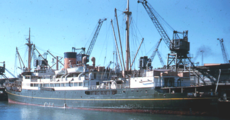
TALES OF TIME: The Matua
The Matua was the famous Twin Screw Motor Vessel that in her time connected the Pacific. Auckland is known as the home of a large population of Pacific Islanders and is referred to by many as the Kava Bowl of the Pacific because of how many islanders gather around it. Different generations of Pacific people reside in Auckland and make up the fabric of this city. We know the common and modern stories of families hopping on flights in recent years to start their lives in Aotearoa, but what about those who came before the journeys were only a few hours long? {{21610}} This is where the stories of the Matua come in. The vessel carried many first-generation Pasifika families to New Zealand between 1935 to 1970. The vessel catered for a large number of deck passengers to enable Pacific Islanders to move between the islands. Throughout her service, Matua was a popular vessel and was reputed to be a favourite of Her Majesty Queen Salote Tupou of Tonga. The word "Matua" is common to most Polynesian languages and usually means "kinship." In New Zealand and around the Islands the vessel was popularly referred to as "The Banana Boat." {{21608}} Many older generations of Pacific Islanders have their own personal stories of traveling to Aotearoa on the Matua. Stories of great importance in order to understand Pacific history in New Zealand. Luckily for those in Auckland, The Auckland War Memorial Museum has a specific display in their new Tāmaki Herenga Waka: Stories of Auckland gallery on the Matua and her passengers. You get to see a beautiful assortment of stories from different voyages. There is an interactive touchscreen display where you can browse through passengers' stories, trinkets they have kept, and historic photos of those times. You can even listen to first-hand accounts of the voyage. {{21613}} The stories of the Matua are ones of great importance to Pacific people in Aotearoa and many of our elders hold Matua tales of their own. Elders including the mother of Judge Ida Malosi who traces her families start in Aotearoa back to the Matua. In the series Daughter of Migration, she talks about her journey on the Matua and how it brought her family here. {{21614}} If you or your families have stories of the Matua we'd love to hear them!
-
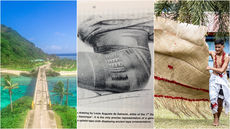
TALES OF TIME - 'THE SPACE BETWEEN OFU & OLOSEGA' - A SECRET METAPHOR FOR RELATIONS BETWEEN SĀMOA AND TONGA
By S. Si'ilata (c) 2021 Like all neighbouring countries, Samoa and Tonga have a complicated relationship that has spanned back to legendary times - however the relationship between these two countries as well as others including Fiji and Uvea & Futuna could not be told without mentioning the actions of each nation in each-others' histories. {{21345}} Clearly things weren't always peachy between neighbours as language relates; the Samoan word from ancient times for a scheme or trickery is the word 'togafiti' - literally meaning, 'Tonga and Fiji'. And Tongan expansion throughout western Polynesia really didn't help them win many local popularity contests during the heyday of Tu'itonga rule - a few of whom were born to Samoan mothers by the way, after the reign of Kauulufonua-fekai remembered in Samoan history as Tuitoga Fa'aulufanua. {{21347}} But for better or worse, there is no denying that Samoans and Tongans not only came from the same origins but were constantly in each-others business right throughout history. As examples remember that the first Tafa'ifa ruler of Samoa, Queen Salamasina was part Tongan - her mother Vaetoeifaga being the daughter of the Tuitonga (King of Tonga) at the time. Likewise the first Tu'ikanokupolu ruler of Tonga named Ngata was half Samoan - his Samoan mother securing aid from her father 'Ama of Lotofaga, Safata for her son - which is itself remembered in the Tu'ikanokupolu title itself mentioning 'Upolu' where 'Ama came from. So in the end how should we view Samoan and Tongan relations? {{21349}} History in Tonga is very clear that the body of the Tu'itonga was so sacred (tapu) that no ordinary Tongan was able to touch him - this created a problem for Tongan kings wishing to be tattooed. The answer was clear - non-Tongans were able to circumvent the tapu of the Tu'itonga because they were foreigners and there was none better at tattooing than the Samoan tufuga ta tatau anyways so when Tongan kings wished to be tattooed they would sail to Samoa with a large entourage and be tattooed by Samoan tufuga there generally creating a huge celebration. {{21351}} One Tu'itonga in particular is remembered for sailing to Samoa numerous times including twice to the Manu'a islands to complete his malofie tattooing. From these trips he gained the nickname Fatafehi Fakauakimanuka or Fatafehi 'who travelled twice to Manu'a' for his Samoan tattooing, and as befitted such a high ranking guest, he was gifted two 'kie hingoa' as Tongans call them or 'ie o le malo - state fine mats. The first was named 'Fala taua o le Tuimanu'a' meaning 'Treasured war girdle of the King of Manu'a' - a name that clearly shows the prestige of the occasion and a worthy gift from one king to another. {{21353}} The second state mat (sorry I use the word fine mat so you know what I'm talking about but that base word 'mat' really doesn't do our famed 'ie justice! It would be like calling the British Crown a 'metal hat' lol) - anyways, the name of the second 'ie o le malo was named, 'Vā o Ofu ma Olosega' literally meaning 'The Space between the islands of Ofu and Olosega'. Now Ofu and Olosega were two of the three Manu'a Islands and at first the name seems a bit lackluster or uninspiring compared to the title of the first 'ie given and yet there is a secret meaning to this title. To understand its meaning you have to understand the 'space' or gap between the islands of Ofu and Olosega. Anyone who has visited these islands knows that the space between these two islands known as the 'Asaga Strait' isn't far but very close - so close in fact that in ancient times when it was low tide, people could walk or wade across the sandbars that became visible. {{21355}} Today, people don't even need to wait for low tide as there's a permanent bridge built connecting the islands of Ofu and Olosega. If you understand this you can understand the meaning of the fine mat - it was a metaphor for relations between Samoa and Tonga - as Tu'itonga Fatafehi would've realized, having seen the Asaga Strait for himself during his two trips to Manu'a. The metaphor is simple: the space between Ofu and Olosega represents the divide between Samoa and Tonga. {{21357}} When the tides of war and history run high, at first the two appear completely distinct and separate from each other much like the peoples of Samoa and Tonga, and yet, when the tides of history finally recede, we realize the truth, that across those sandbars the two islands are actually connected - the two peoples are actually one. And despite all the history, good and bad, if we trace our gafa (genealogy) back far enough we are not only linked - we are from the same ancestors. {{21359}} Maybe thats why I have a love for Tongan history just as much as Samoan history, and thats why when Tu'itonga Fatafehi Fakauakimanuka completed his Samoan malofie he was given a Samoan fine mat specifically titled 'Va o Ofu ma Olosega' to remind him of a truth we should all know - that we are one! {{21361}} And that doesn't take away from our differences which we know there are and the distinctions in our Samoan and Tongan cultures but we do have the same roots - God and Our People - especially in this global age where the world is so much bigger and there are a great many other cultures too. Va o Ofu ma Olosega S. Si'ilata (c) 2021
-
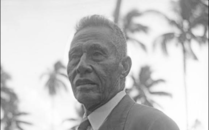
TALES OF TIME - A Visit to Legendary I’iga Pisa, at Falefa, Samoa, 1957
The remarkable I’iga Pisa and members of his family were photographed by visitors from New Zealand in 1957. {{20652}} I’iga (born 1882) was one of several chiefs who were exiled by the Germans along with Lauaki Namulau'ulu Mamoe to Saipan in 1909 because of their adherence to the Mau a Pule nationalist political movement. I’iga had been a key organiser for Lauaki in the lead up to exile. New Zealand archaeologists Jack Golson and W.R. Ambrose befriended the Pisa family at Falefa in the late 1950’s, and the two took these photos of I’iga, the Masiofo (wife) and other members of the family during a visit to Falefa, Upolu, in 1957. {{20658}} Afioga I’iga became famous in 1915 for escaping from exile and paddling a dugout outrigger canoe from Saipan to Guam, a distance of more than 150km over a period of several days. I’iga navigated by the stars. He fell asleep and lost his paddle in the dark when nearing the island of Rota, approximately half way to Guam. However, he made it to shore and was looked after by locals, until he began the second leg of his journey (with a new paddle). {{20655}} He was repatriated from Guam to Samoa, via Hawai’i, seemingly in the early 1920’s. I’iga reportedly worked for the Department of Samoan Affairs, under the New Zealand Administration, until 1942. When the Samoan flag was raised on the first day of independence on 1 January, 1962, I'iga was the only one of the exiled matai from 1909 who was still living. He was home unwell and couldn’t attend, but the faint sound of the Samoan anthem playing in the distance instilled immense pride, knowing what he and others had sacrificed for sovereign independence. He died in 1965. {{20661}} . #WATCH 1918 Samoa - Talune & the Ship of Death {{20668}}
-
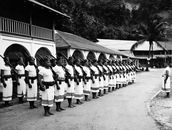
TALES OF TIME - FITA FITA GUARD
The Fita Fita Guard served the US Navy in Am Samoa until 1951. In 1900, its orginal name was Samoan Naval Militia. It was such a great honor for Samoans to serve that the term Fita Fita, which is Samoan word for soldier was adopted by the US Navy. The island's location, along with the vital and vulnerable US-Australian supply line in early 1942, meant the territory had to be held to allow the flow of men and supplies west. Expanded during World War II, Fita-Fita Sailors manned anti-aircraft batteries, and other positions around the U.S. Naval Station Tutuila. {{20096}} When the US Navy disbanded in Am Samoa in 1951, Fita Fita Guards who wished to stay and continue serving in the US Navy were transferred to the Navy Reserve. The guard wore a naval version of the traditional attire, a wrap called lava lava, and the traditional headdress, along with a military issued undershirt and no shoes. {{20098}} Fita Fita Guard Tuiofu Fo'isia was born in Ofu, Manu'a on November 11, 1918. His name at birth was Fo'isia Misaalefua. His parents are Se'e Palega Misaalefua and Elesiva Misaalefua. Fita Fita Guard Tuiofu Fo'isia, is the first Native Samoan to be decorated in World War II. He received the Purple Heart after being wounded when a Japanese submarine shelled Samoa on January 11, 1942. Tuiofu Fo'isia continued his career in the US Navy and was sent to Hawaii. A year later his older brother Misaalefua Tausulu helped his wife Fa'apio Telesia Fo'isia and children reunite in Hawaii. {{20100}} In 1962, Tuiofu Fo'isia retired from the US Navy, by this time his family was already settled and established in Carson, CA. Tuiofu Fo'isia and his wife Fa'apio had 12 children. His next path in life he became an ordained minister and founded the First Samoan Congregational Church in Carson. He became known as Rev Elder Tuiofu Fo'isia in Carson, and gave the rest of his life to serving God and the Church until he passed away in 1982. His late son James Misaalefua Fo'isia has a park in Carson named after him. And in Ofu Manu'a the Executive Office Building is named after his older brother, Afioga Misaalefua Tausulu Palega EOB Building. {{20102}} Civilian war correspondent Robert Doyle took the below photograph of a Fita Fita guard standing on the sidewalk in Tutuila. He wrote this caption: "Talamama, seaman, second class, is member of Fita Fita guard (U.S. navy honor guard). Stripes around bottom of lava lava denote rank. Talamama gets regular navy pay, plus 20% overseas pay, although he is not permitted to serve outside his home islands of American Samoa. Talamama was right on ball, demanded to see my credentials before he would permit me to take his picture." {{20105}}
-
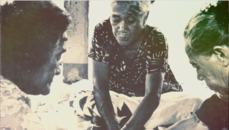
TALES OF TIME - Skilled Siapo makers from Ta’ū Manu’a
1966 photo of Fa’amanū Lefiti, Leitupā Lifa Niumata, So’oupu Aina Nua, skilled siapo makers from Ta’ū Manu’a. Siapo, often referred to as tapa, is a traditional mulberry bark cloth of Samoa. The dyes used to paint and design siapo, all come from nature they are: O’A - Brown Dye LOA - Red Dye LAMA - Black Dye AGO - Yellow Dye SOA’A - Purple Dye Soa’a a popular and rare dye for siapo. Its juice would be extracted from the stem of a mature soa’a. When cut in half it is purple. It was a popular dye in Manu’a to create a deep purple almost plum color used to emphasize design and symbols on siapo. PC - George Hastings Check out more about our Tapa of the Pacific here - {{19939}}
-
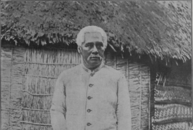
TALES OF TIME - ARMS SURRENDER - 121 YEARS BACK
By Michael Field I’ve always liked a photo that appears in Sāmoan history, but usually without explanation. Eight or so fautasi, crowded around a large ship in Āpia harbour. Now I know and it’s quite a story, set around events of 1899 in Sāmoa. Depending on who is telling the story, and why, the photo shows a moment that marks the end of a “civil war” between Mata’afa Iosefa and Malietoa Tanumafili. The other more accurate version is that the picture shows one of the final acts in a war between Britain and the United States aimed at preventing Germany taking over Sāmoa. Thousands of Sāmoans were killed and maimed for this imperial chess game. The three powers set up a trilaterial commission to end the affair and its three members were sent to Sāmoa to negotiate an end to the conflict they started. They travelled on a United States Navy ship. This is a bit of the story …. {{18261}} On 13 May the USS Badger sailed into Āpia. An unprepossessing converted merchant ship, christened by being the first US naval vessel named after a burrowing mammal, she carried the members of the trilateral commission. “The sun was just emerging from the eastern sea, its rays were just lighting up the green summits of the island mountains in front of us,” the American commission member, Bartlett Tripp later wrote. “The sea was calm and quiet, save that continuous billowy motion, that restless swell which never ceases and which is ever reminding you of that terrible reserve force it can bring into action when it desires.” Malietoa’s forces were visible on the shore “while in the distance could be seen the fortifications and troops of the hostile forces of Mataafa. Drums were beating and flags were flying.” Āpia had the appearance of a battlefield: “The shells from the war vessels, fired to dislodge the forces of Mataafa, had left their marks upon the houses and plantations surrounding the town and within a radius of 3 miles from the inner harbor, while the lawless acts of looting and foraging parties from either camp had left them a scene of devastation and desolation which always succeeds the invasion of armed forces of savage and civilized men… The white people whose homes had been pillaged and who had sought refuge in Apia, under the guns of the men-of-war, despondently awaited events which might again bring peace, and the inhabitants of the unhappy town, whose houses had been unluckily struck by the shells of a friendly fleet, and who sought shelter upon the shore, were about equally divided in their words of censure for the hostile forces of the natives and the vessels of their own fleet.” {{18263}} It was suggested by the commission that both sides surrender their weapons. Tripp said naval officers thought this to be impossible as Sāmoans were in love with their guns and no act, no crime would get them to give them up: ‘“They can only be disarmed by a force sufficient in strength to take their arms by force”; and our attention as called to the attempt to disarm the forces of Mataafa a few years before when the German forces on the island were nearly annihilated. A breakthrough occurred when Mata’afa agreed to meet with the commission on Badger. Several hundred went to the ship but only Mata’afa and 13 chiefs went aboard. “It was a very pretty and unique sight to see these warriors in their native costumes as their fleet of boats approached our vessel,” Tripp said. In Mata’afa he saw a man wearied by exile. He was 67, his work was nearly done, and wanted to be permitted to die and be with his forefathers. “Mataafa was clad in a long white robe which came down to his feet and was partially gathered at the waist by some form of belt but flowing somewhat loosely about his large stalwart form, giving him, with his dignified mien and presence, something of the appearance of a Roman Senator. His head and feet were bare, and he wore no ornaments of any kind except a necklace of beads and a cross, the emblems of his church.” {{18267}} The chiefs with him wore just lavalava. They were freshly oiled which “brought out distinctly the brilliant tattooing of the truck and limbs … and the splendid muscles of the limbs and body were displayed to best advantage by their native dignity of carriage, which is a distinguishing feature of their race. One or two suffered deforming filariasis but most, all over 1.8 metres, ”were a splendid looking body of men physically as could be seen in the prize ring or practicing rooms of the gymnasium”. Carrot and stick followed. The great powers were sorry that Sāmoans were at war with each other. If they did not stop, the powers would send bigger ships than those already there to compel obedience: “if Sāmoans thought these vessels were large and their guns powerful which could reach Sāmoan houses three miles from shore, what would they think of the great war vessels of these nations which could fire great shells four times as far; which from the shore could destroy every Sāmoan house and village, and ruin and make waste every part of these beautiful islands…” It was put to Mata’afa that he should break up the camps and surrender the weapons. “Without communication with his chiefs,” Tripp said, “Mataafa drew himself up to his full height and slowly and with great dignity replied that he had read and heard of the wealth and power of the great nations from which the Commissioners came; that the Sāmoans had nothing but thanks to return to the great powers for what they had done for his people in sending the missionaries to teach them to be good, and to read and write.” The weapons were private property that each man had paid for: “they loved their guns; they had cut much copra and worked hard to obtain them.” {{18269}} Mata’afa wondered how the richest nations on earth could “compel the poor and ignorant Sāmoans to surrender up their property to those who did not need it; that the rich should take from the poor, what to them was so much; that the strong should with threats of force compel unwilling action of the weak; that Christian nations should send their missionaries to teach them morals, and their commissioners and soldiers to deprive them of their liberty and property.” Mata’afa said they would not be a party to a peace that robbed them of their property and honor; “They preferred to become slaves, if they must, by compulsion and now by cowardly submission.” The commissioners said they did not want the guns for themselves, but as a sign of good faith: “Where the guns of Mataafa would shoot 100 yards, those of the great powers would shoot 300; and where they could load and fire their guns a single time, the guns of the great powers could be discharged fifty or a hundred times.” Again, Mata’afa rose: “His eye was bright and his voice clear, and he said with an inquiring tone, “If Mataafa lays down his arms will all Sāmoans lay down theirs? Will Malietoa Tanu, will Tamasese give up their guns?”’ The commission said that would be so. Mata’afa immediately agreed. “The ending was so sudden,” Tripp said, ”the great object sought had been reached so quickly and unexpectedly, that at first the Commissioners were unable to comprehend its real effect.” {{18271}} Food and drink were served. Mata’afa and party left the ship: “As they rowed away with their gay flags and banners waving in the light of the setting sun, singing their native songs accompanied by the music of their native instruments, it made one of the most unique and picturesque scenes I have ever witnessed.” On 31 May Badger steamed around Mulinu’ū to Malie where Mata’afa and his men were ready to surrender 1800 guns. The commissioners said that was not all the weapons. Mata’afa agreed, saying there were weapons still in Savai’i but the seas had been too rough to go and get them. There were another 200 on the other side of ‘Upolu but they promised to surrender them. The commissioners believed Mata’afa; guns were handed over, receipts written out. Cabin bread and tea were given to all. {{18265}} “Several old chiefs desired to have photographs of their guns,” Tripp said, “and in accordance with their wishes the artists on shipboard took pictures of themselves with their guns in their hands, copies of which pictures were afterwards given to the chiefs. Nearly all kissed their guns at parting with them, and then went cheerfully to their boats and returned to the shore.” Malietoa’s guns were surrendered: “needle guns, Winchesters, Springfield rifles, Mausers, etc, some early useless from exposure to weather, but many of the newest patterns and were kept clean and bright.” Four thousand guns were surrendered. Mata’afa and Malietoa, accompanied by 26 chiefs, went aboard Badger together to meet the commission on 20 June. Tripp was moved by what he saw: “…each chief grasped a chief of the opposite party by the hand and in accordance with the custom of the tribes inhaled his breath, a custom which generally prevails in the south sea islands among the Polynesian races. Instead of kissing they bring their noses together and inhale each other’s breath. This lasts for several seconds, and the attitude of the actors is much the same as in the act of kissing.” With that speeches and a meal of canned salmon, meats, sea biscuits and tea followed. {{18273}}
-
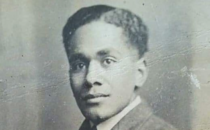
TALES OF TIME - Fiji’s forgotten wartime fighter pilot
By Michael Field In September this year, a grounds man at a lovely Yorkshire cemetery might just notice that 76 years earlier, that day, one of Fiji’s finest died. Some how, Fiji’s first ever pilot, has slipped away from history. The tombstone at the Commonwealth War Graves section of the Harrogate (Stonefall) Cemetery lists him, under the crest of the Royal Air Force, thus: 1553660 SERGEANT I.D. KOMAISAVAI (OF FIJI) PILOT His full name was Isikeli Doviverata Komaisavai. When he died of pleurisy on 19 October 1944 in a hospital in Aylesbury, he was just 24-years-old. {{17790}} Most people knew him as Ratu Dovi. Complicating matters further, the sole reference to him in an RAF history calls him “Raten Kokaisavai”. His death was noted in the Fiji Times and in the Auckland Star, which the latter had under a sub-headline “Descendant of King Cakobau”. The Star said: “Ratu Dovi was the only representative of the Fijian race to have the distinction of serving with the R.A.F.” He was born in Tailevu, the son of Ratu Savenaca Komaisavai and Adi Miriama Komaisavai. Like a number of the sons and daughters of high chiefs in those days, the promising children were shipped off to school in New Zealand. Ratu Dovi (it is likely that is what he was known to his peers as) found himself at Wanganui Technical College (now Whanganui City College) from 1936 to 1939. The Star said he had “a brilliant school career” there. He was captain of the first 15 in rugby and the first 11 in cricket. He was the vice-president of the school council. World War Two broke out in 1939. Ratu Dovi returned to Fiji, then a British colony where his uncle, Ratu Lala Sukuna, was recruiting Fijians to fight for king and commonwealth against the Nazis. {{17787}} Ratu Dovi and several white settlers volunteered and were accepted for the RAF in 1941. Through New Zealand, Ratu Dovi was taken into the British Commonwealth Training Plan and sent to Canada to learn to fly. New Zealand had 2,743 pilots trained there. That number includes Ratu Dovi who, upon getting his wings, was sent to join No 234 (Madras Presidency) Squadron, Coastal Command. The official RAF account of the squadron says that when Ratu Dovi joined 234, it was based in southern England. From there it was using Spitfire VBs (with the letters “AZ” on them”) to conduct sweeps over northern France, hoping to catch out German bombers. Ratu Dovi was not the only non-Britain in the squadron; it was dominated by Danes who had escaped Nazi occupation. They even purchased the planes they were to fly in. {{17793}} In January 1943 it was moved to the Orkney Islands, returning south in June 1943. Its main mission at that point was convoy protection out over the ocean. For some one like Ratu Dovi, the Orkney Islands must have seemed like a frozen bleak hell. The record is blurred now, but it looks as if Ratu Dovi become ill with the lung disease pleurisy in January 1944. Pleurisy is often a symptom of something more serious and he found himself hospitalised. His squadron covered the Normandy invasion in June 1944 and then converted to P-51 Mustangs for long-range bomber escort duty. Ratu Dovi made it briefly into an official RAF account of the war. He was listed as being a member of an ethnic minority community who had volunteered to serve. “It is difficult to determine how many of the volunteers from the Colonies were ethnic minorities as the RAF had no colour bar, and did not allocate distinctive Service Numbers to ethnic personnel nor annoted a person’s Record of Service with an ethnic origin,” the account says. {{17795}} “Coloured British subjects from the Colonies were eligible to join the RAF on the same terms as white subjects of the Crown.” Ratu Dovi, for the most part, has become an unknown warrior. His name and photo is on the roll of honour at Whanganui City College, along with others from the school who died in the war. The Auckland Star noted: “Ratu Dovi was a descendant of Cakobau, the last Fiji king, and one of his grandparents was a signatory to the Deed of Cession.” The street in Suva, Ratu Dovi Road, is not named after the flier but a family member of an earlier generation. Perhaps its time to name something significant after him. Around the world there are airports honouring celebrated aviators: Edward Logan (Boston), Edward O’Hare (Chicago), Jean Batten (Auckland International), Lofton Henderson (Honiara) and Harold Bauer (Port Vila). So perhaps Nausori International Airport could become “Ratu Dovi International” – complete with a plaque to remember Fiji’s first and only fighter pilot.
-
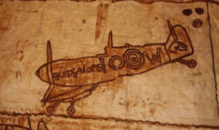
TALES OF TIME - PACIFIC SPITFIRES
By Michael Field Early in World War Two both Samoa and Tonga raised money to buy Spitfires. Tonga did rather better, coming up with the money for three while then New Zealand ruled Western Samoa purchased one. Samoa’s contribution was, perhaps, all the more remarkable because of its unique involvement with the New Zealand air force. Just 10 years before the fund raising, Western Samoans had been at the receiving end of the newly formed air forces’ first operational mission. Just weeks after New Zealand Police had gunned down 11 Mau marchers on Apia’s Beach Road the air force arrived in the form of a Moth seaplane, aboard HMS Dunedin. It was flown to hunt Mau in the jungles behind Apia. Occasionally it fired shots at distant figures, but was mostly useless. The climate so damaged the plane it had to be scrapped. {{17778}} A decade on, the war against the Nazis was more pressing and Western Samoa’s banana farmers donated six-pence per crate of exported bananas, raising £5,723 (around the equivalent of $1 million in 2016) for a Spitfire. The resulting Mark V Spitfire was christened Western Samoa and deployed to New Zealand’s 485 Squadron. It was flown by Auckland born Sergeant Andy Kronfeld. His mother was from the Fiame family of Lotofaga, Samoa. His German side came from Tonga. Kronfeld managed to shoot down a German and he survived the war. The plane did not. It was transferred to an Eagle Squadron – American volunteers in the Royal Air Force. It was shot down on 31 July 1942 over Abbeville, France. Its pilot, Norman Young, was killed. {{17780}} Tonga had not been enthusiastic about World War One, but Queen Salote was keen to join with the Allies when World War Two came around. Tonga, although nominally self-governing, was controlled from London. Salote ordered fund raising for three Spitfires and eventually £15,000 (around $3 million today) was raised. Three Spitfires were ordered and named Queen Salote, Prince Tungi and Tupou I. The gifts were marked also with tapa design. The Mark V Spitfire Queen Salote went to RAF 602 City of Glasgow Squadron and became the personal plane of Brendan ‘Paddy’ Finucane. Born in Ireland, he had a shamrock motif on the fuselage. There was a small problem with the name on the plane: it had been written “Queen of Salote”. When the War Office noticed it in photos, the “of” was painted out. {{17782}} Finucane was an ace. He was officially credited with 28 kills and may have had as many as 32. He continues to hold the record as the youngest pilot ever to hold the rank of wing commander, promoted to the position when he was 21. Finucane was killed soon after, attacking a German Army at Étaples, France. Queen Salote was hit in the radiator by a German machine gun. Finucane turned back to England but 13 kilometres off Le Touquet on the French coast, he broke radio silence and sent his last message. He was heard to say “this is it butch” before ditching. Finucane drowned. Prince Tungi, a Mark IX Spitfire, went into 485 Squadron in 1944. Transferred to the Mediterranean, it ended its days when it ran out of fuel on a mission over Sicily and crashed near Catania. The fate of the third Tongan Spitfire, King Tupou I, has slipped through history’s gaps. {{17784}} Fiji also had a Spitfire connection, as I have written of here. Sergeant Isikeli Doviverata Komaisavai is recorded in military a history as “the only representative of the Fijian race to have the distinction of serving with the R.A.F.” He flew Mark V Spitfires, first out of South England before his squadron was moved to the Orkney Islands. He died of pleurisy in January 1944.
-
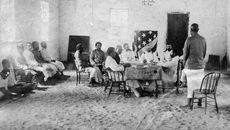
TALES OF TIME - How American Samoa came into Existence
By Michael Field 120 years ago, American Sāmoa came into existence. This was the result of imperial games in the 1890s which saw Britain, Germany and the United States divide up bits of the world they felt needed White Man’s Rule. What we now know of as Sāmoa became a German colony when their Second Reich’s flag was raised on 1 March 1900 at Mulinu’ū. Men from SMS Cormoran formed up outside the German School on Beach Road and marched off down the peninsula. Americans from a collier, USS Abarenda, followed. German-American antagonism had given away to common cause; the division of Sāmoa. Near the back of this parade was an assortment of mixed culture people, already cursed as ‘afakasi’ or ‘half-caste’. The Sāmoa Weekly Herald said they were ‘all dressed nicely’. Sāmoans came up the rear: ‘We should say that fully 5000 natives were present…,’ the Herald said. ‘During the whole of the celebration the natives behaved on the whole very well.’ {{17600}} Cormoran Korvettenkapitän Hugo Emsmann, 43, insisted he should raise the German flag as he had been longer in Sāmoa than the new Governor, Wilhelm Solf. In the end they did it together. And then came American Sāmoa... On Tuesday 17 April 1900, people gathered on Saugelau Hill, overlooking Pago Pago harbour, 128 kilometres east of Mulinu’ū. A serpentine-like haven sheltered by towering jungle clad mountains, it gave gravity to Washington’s first successful territorial claim in the South Pacific (there had been others, such as Tokelau and atolls in modern Tuvalu to the north, not recognised by other nations). Because there were few public buildings in Pago Pago, the ceremony was run from USS Abarenda, commanded by New Englander Benjamin Franklin – ‘BF’ – Tilley, 52. Sāmoans, in their Sunday whites, heard Tilley read a proclamation from President William McKinley declaring the islands ‘to be under the sovereignty and protection of the United States of America…,’ Mrs. Henry Hudson, wife of Abarenda’s Chief Boatswain Mate and the first navy wife to live in American Sāmoa, hoisted the flag. {{17598}} The New York Times published an account based on reports submitted by Tilley. ‘We rejoice with our whole hearts on account of the tidings we have received, the conventions of the great powers concerning Sāmoa are ended,’ the chiefs were quoted saying. Pastors blessed the gathering. Abarenda and Cormoran fired 21-gun salutes. School children sang; dances, sports and games followed. Tilley commented that the feast saw the locals eat ‘so much pig that it is a wonder that they survived’. Lloyd Osbourne, stepson of author Stevenson, commented that ‘all seemed much pleased to feel that they were henceforth to be under the flag of ‘Amileka.’ The event was spoiled somewhat by Manu’a, 114 kilometres east, declining to be American. Tilley said the Americans meant ‘to shield them from unscrupulous people.’ Tui Manu'a Elisara replied they were not ready to decide. {{17602}} As Berlin and Washington and later Wellington would find out Sāmoans had a passion for long deliberation. Trying to rush the ali’i and tulāfale was a futile activity. Manu’a eventually signed a deed of succession on 16 July 1904. Cover image: Captain Benjamin Franklin Tilley Holding court, 1900. Image PH102-C, courtesy Polynesian Photo Archives, The Dwyer Collection, Feleti Barstow Public Library, American Samoa. Photos from the International Journal of Navy History
-
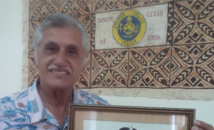
TALES OF TIME - The Life of Hans Joachim Keil
Known as Joe Keil, I was born 11 May 1944 the second son of William and Violet Keil. My earliest recollections were happy ones being raised on a cocoa and coconut plantation at Lotopa, which belonged to my grandmother Hazel (nee Kennison) Elkins-Harrington-Mugele-Hack. We lived in a big old house on the river bank, and we were free to roam the plantation eating all the fruits like esi, mangoes, vi, coconuts, sugar cane etc. I learned to swim at a very young age and we swam in the river every daily. I attended primary school at Leifiifi with my other cousins from Lotopa - Olaf, Klaus, Herma, Alfonso. We walked to and from school every day as there were no buses and few cars on the road. {{12642}} As a young boy, I built and captained a ship made of corrugated roofing iron and wood that Richard and August and I would float down the Vailima stream. Every Saturday, my brothers and I would go to the movies in town. We loved cowboy movies, musicals and Zorro. This is how I learned the art of sword fighting and practiced regularly on my younger brothers. In August 1952, at age 8, my mother took Richard, August, and myself to join Melvin and attend school in N.Z and live with my grandmother Hazel and my Aunty Ligi. We travelled on the Union Steamship "Tofua". It was a happy trip for me as I enjoyed roaming all over the ship. On the way we stopped in Suva for a day. Richard and I stayed in NZ while August returned to Samoa with our mother. {{12663}} From 1952 to1959, I attended Napier St. School, Mt Albert Primary, Kowhai Intermediate and then Auckland Boys Grammar, the top school in NZ for education. We stayed with our grandmother, Hazel all this time. I represented my schools in swimming, athletics, and rugby. My brother Melvin and I joined a men’s choir which gave us the opportunity to travel around NZ. We also volunteered to help build the LDS temple in Hamilton. When I was 9, I started working a newspaper route and whatever money I earned, I gave to my Granny Hazel. Once a week, I would catch the bus by myself to the fish market to get free fish heads for our sua i’a. {{12648}} I would also take Richard and sell souvenirs at rugby games to earn more money. Granny Hazel passed away in 1959. At 14 I fell in love with Rock ‘n’ Roll and started sneaking out at night to a club called the Orange where I would watch, and sometimes perform with, my older cousins in the Keil Isles band. I learned to sing and play the guitar but nowhere near as good as my cousins. At 15, I was sent back to Samoa to finish my last 2 years of high school at CCWS, Pesega. I bought a motorcycle and enjoyed giving rides to pretty girls. It was during this time that Aleki Wright also joined our family. {{12650}} In August of 1961, our parents separated and my mother took Richard, August, Hermann, and myself to Hawaii. Melvin, who was still in NZ, joined us the following year. In October of 1961, I enlisted in the U.S. Air Force and attended basic training in Lackland AF Base, Texas then went on for technical training at Chanute AF Base, Rantoul, Illinois. This was my first experience with a snowy winter and it was a very cold one. With my aircraft electrician training completed, I was assigned to Beale Air Force Base, 50 miles north of Sacramento, California where I maintained a fleet of B-52 Bombers and KC-135 aircraft. The work was very challenging and interesting and I regularly took hops on military aircraft to visit my mother and brothers in Hawaii. {{12646}} I took evening classes at Yuba College taking courses in history, mathematics and psychology and on my weekends off-duty I would visit San Francisco and stay with Meleke Auro and his family or visit Hayward and stay with Auntie Vickie, Uncle Faiga, Elva and Sulaika. I enjoyed these visits very much and made many friends in the San Francisco Bay Area. After my discharge in October 1965, I moved to Tulsa, Oklahoma to attend flight training at Spartan School of Aeronautics while working at American Airlines as an aircraft electrical repairman. In 1967, I was called on an LDS mission to Samoa and served under Pres. Price and Pres. Shute. The mission was a very humbling experience for me. I traveled from Manua to Falealupo, Savaii and came to know the people, customs, and traditions and learned to speak the language fluently; which was to be of great use to me in my later life. One of my mission companions, Tuifao Tufuga became a lifelong friend. {{12656}} After my mission I returned to Tulsa Oklahoma to finish my flight training. My mother and brothers had moved to Orange County, California. Richard had joined the US Army and August had joined the Air Force. While attending flight school in Tulsa, I made many friends and participated in many church activities for Tulsa Third Ward. I stayed with a wonderful couple Jim and Bonnie Blamires and their family who worked for American Airlines. August and Hermann also stayed with then Blamires while attending Spartan School of Aeronautics in Tulsa and we have remained dear friends. In 1970, I returned to Samoa and began my flying career first with Air Samoa and then with Polynesian Airlines. The aircraft I flew included Cessnas, the Britten Norman Islander, the Douglas DC3, the Hawker Siddely 748, and the Boeing 737. (Note: Dad was the first Samoan pilot to return and fly commercially here in Samoa for Air Samoa and Polynesian Airlines). {{12661}} My favourite aircraft was the DC3. Many locals began joining the company, Grant Percival, Jennings McDermott, Danny Rankin, and my good friend Mark Berking. My cousin, Elva's husband, Harry Gallagher joined Polynesian. My brother August returned to Samoa after his flight training at Spartan and he and I had flights together on many occasions. In 1971, I married Celine Hellesoe. We have three girls; Violette, a pilot for Hawaiian Airlines and a Registered Nurse, Bella who performs with the Duttons in Branson, Missouri, and Katrina, a professional photographer. And, in 1985, our special boy Nathan, was born in Hawaii. As a child with Down Syndrome, he had a very hard time as a baby but he is now healthy and strong and the joy of our family. {{12659}} In February 1988, I successfully ran for Parliament representing the Individual Voters Roll, those of European descent who are not tied to the matai electoral system. As a Member of Parliament, I served as the Minister of Transport and then the Minister of Trade and Tourism and put to good use the knowledge of the Samoan language that I had gained during my LDS mission. I travelled all over the world representing Western Samoan in overseas meetings with the United Nations, European Union, and other international organizations. After five terms and 23 years in parliament, I retired from politics in 2011. {{12654}} I do not miss the political life. In March 1996, our family opened up the first McDonalds Family Restaurant in Samoa along with my father and the Schwenke Family. In 2006, we established TV3, the first privately owned TV station in Samoa. Some of our key programs, such as Samoan Idol, Young Stars singing competition, the National Spelling Bee competition, and the 8 Days of Christmas, have nurtured the talents of our Samoan youth. We also proudly broadcast live the Joseph Parker fights and LDS General Conference. I now try to live a quiet life of reading, research into the Samoan history and the European involvement, and collecting the history of the Keil family. {{12652}} My favourite hobbies are reading and swimming with my son, Nathan who is now 33 and very popular. He is such a blessing to Celine, myself, and our family as well as everyone he meets. Celine and I also spend as much time as possible with our kids and nine grandkids (Tiana, Natalia, Selena, Rex, Nathaneal, Leila, Tama, Tara and Toa) in the US and they enjoy their visits to Samoa whenever possible. *excerpt written by Joe (and edited by his children) for the Keil Reunion book, which he edited and published.
-
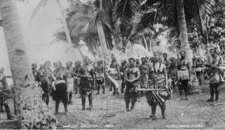
TALES OF TIME - SAMOAN WOMEN AT THE FOREFRONT OF BATTLE
By Michael Field History, in Sāmoa, is mostly about men. Often it is not even about Sāmoan men, but odd mercenary characters from other lands. Sāmoa tourism promoters spend millions idealising Robert Louis Stevenson and always overlooks the rich characters around him. Many Sāmoans may be unaware of these astonishing characters and the events that surrounded them. Events of 1899, for example, a time when hundreds, perhaps thousands, of innocent Sāmoan men, women and children were savagely bombarded in their villages, by Britain’s Royal Navy and the United States Navy. It’s a little told if astonishing story. As I’ve pointed out before, there are monuments in Sāmoa, Britain and the US to the white men killed in Sāmoa in 1899, but none anywhere to the Sāmoans. The United States awarded its highest bravery honours, the Congressional Medal of Honor, to soldiers who fought Sāmoans... but their victims were forgotten. Some day the story will be properly told. By chance I found at Sydney’s Museum of Applied Arts and Sciences a set of little known photographs taken during the conflict by visiting photographer Charles Kerry. There is a particularly striking shot of a group of soldiers fighting for the young Malietoa Tanumafili who the British and Americans had decided would be ‘king’ of Sāmoa. This was opposed by the majority of the country who were behind the leadership of the remarkable Mata’afa Iosefa (or Iosefo - literally depending on your religion). What is striking in Kerry’s photograph is the obvious leadership of two women. Their names, today, are unknown but there is no doubting their significance. {{12179}} Link to Museum of Applied Arts & Sciences story here On the right is a tall, defiant looking woman. She shows no intimidation, no suggestion that she is out of place, or posed. She holds a large knife, no doubt ready to use. Off to the left is a shorter woman - perhaps even a girl - also with a knife, seemingly swinging it. Behind the women stand around 30 men, ready for battle of some kind. The war of 1899 was fought with a wide array of technologies; from bush knives to a special kind of high explosive naval shell that was tested by the Royal Navy on villages and their civilian occupants. The next time it was used was in the Great War on soldiers. Perhaps, some might say, these two women were ceremonial - they might taupo. But then there is this picture: {{12181}} Link to Museum of Applied Arts & Sciences story here And clearly there is a woman in the second row, levelling her rifle. The New Zealand war correspondent Malcolm Ross also took photos of women in front line action. The best known of them is this one with two women at the lines in the siege of Āpia: {{12183}} Link to Collections of the Alexander Turnbull Library here Again the women are unnamed (the white men are all named). One of the women could well be Tulia, a taupou from one of the nearby villages. It could be Tulia. Malcolm Ross made her something of a celebrity and in a newspaper account in Australia said Tulia was “one of the most sweetly pretty girls in Sāmoa”. Ross reported that Charles Kerry created a postcard, for sale, entitled Tulia the Sāmoan Girl. She was said to always on the front line. “In the jungle,” the newspaper reported, “when the men could scarcely see each other, much less their enemies, and with bullets flying all around, Tulia would suddenly show herself, and shout out to the ducky warriors, ‘Fight, fight!’ in tones of earnest encouragement. ‘She is as plucky as they are made’ said one. In his reporting, Malcom Ross called her Tulla or Mary. “She always carried water with her on the march, and at the most critical times she might be observed raising herself from behind a log and handing the men a pineapple, a banana, or some breadfruit. ” Ross asked Malietoa about women being in the frontline and he replied: “It is our custom to allow women to come into the battle with us. If they are there the men will be ashamed to run away. They bring food and water too. Killing makes thirst.” Mata’afa’s men held Vailima at one point when Malietoa’s men attacked it. In the fighting a German flag was found flying there. Reported Ross “It was captured and handed to the taupou, or village belle, who comes with the troops as water carrier.” With that, Tulia disappeared from history, forgotten even by her own people.
-
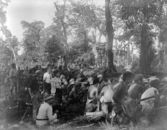
TALES OF TIME - TULIA, FRONTLINE TAUPOU
By Michael Field A forgotten photo from a savage conflict in Sāmoa, this is one of Pacific journalism’s more significant images (above). It was taken in 1899 by Otago journalist Malcolm Ross, New Zealand’s first war correspondent. It was probably April and given Ross’ reporting, it’s likely to have been around Apia; Vailele, Lotapa or Vailima. The more compelling mystery are the two women in the picture. Water carriers and perhaps lovers of the men peering through the jungle for the enemy? {{11968}} The war Ross was covering was a complex imperial affair. Sāmoa was nominally an independent state, governed from Mulinu’ū. Britain, Germany and the United States wanted Sāmoa and their technique was to back particular tama’āiga or paramount chiefs to become “king” of Sāmoa. This played out in 1899 when Germany backed Mata’afa Iosefa as their king while Britain and the United States preferred Malietoa Tanumafili I. Full scale war broke out. For the first time since the War of Independence, Britain and the United States became allies. Warships were sent to Sāmoa and their skill was in what they called “punitive actions” – they bombarded Apia and other Upolu villages without warning. The Americans provided a Gatling gun which was used to pour lead into villages. Many Sāmoans were killed. The Sāmoans on the British and American side wore red turbans; the Mata’afa forces white turbans. Mata’afa’s forces proved very good at fortifications and with the Germans providing ammunition, there was much fighting. {{11970}} An Australian naval officer, Guy Gaunt, was sent ashore from HMS Porpoise to organize a land force. Gaunt became a famous naval officer two decades later, during the Great War, but in Sāmoa he was a young single man with a mission. That is Gaunt in the left of the photo; a dark shirt and a backward sloping hat; leading on a stick or, perhaps, sword. Gaunt’s force – nicknamed “the Never Glorious Army” – were decisive in the fighting. Gaunt went into battle on Sammy, a horse he purchased locally. By his own account decades later, Gaunt was swimming in the Vailima stream, wearing just his underwear, when a couple of Sāmoan women joined him. One of them became close to him; going into battle as a water-carrier. She was said to be named Tulia and was a taupou from one of the nearby villages. It could be Tulia in the photo, barely visible standing behind Gaunt. When the fighting was over and Porpose returned to Sydney, the Daily Telegraph described Gaunt as the hero of Sāmoa and said Tulia was “one of the most sweetly pretty girls in Sāmoa”. She was said to always be with Gaunt on the front line. “In the jungle,” the newspaper reported, “when the men could scarcely see each other, much less their enemies, and with bullets flying all around, Tulia would suddenly show herself, and shout out to the ducky warriors, ‘Fight, fight!’ in tones of earnest encouragement. ‘She is as plucky as they are made’ said one.” The story was so successful that a Sydney photographer created a postcard, for sale, entitled Tulia the Sāmoan Girl. {{11972}} In his reporting, Malcom Ross called her Tulla or Mary. “She always carried water with her on the march, and at the most critical times she might be observed raising herself from behind a log and handing the men a pineapple, a banana, or some breadfruit.” Ross asked Malietoa about women being in the frontline and he replied: “It is our custom to allow women to come into the battle with us. If they are there the men will be ashamed to run away. They bring food and water too. Killing makes thirst.” Mata’afa held the Robert Louis Stevenson homestead at Vailima. The Malietoa red tops attacked it. Gaunt and Tulia were in the fighting and according to Ross, a German flag was found flying there: “It was captured and handed to the taupo, or village belle, who comes with the troops as water carrier.” After seizing Vailima, Gaunt, Tulia and the men went back to Apia where the German flag was handed over to a naval officer. He replied that as they were not at war with Germany, their national flag could not be disgraced. “But the flag had been captured in fair fight from the rebels, and he would take it off to the senior officer to show to him, and report how it was captured,” Ross reported. “It would then be handed back to the taupou.” With that, Tulia seems to disappear from history. In the photo, of course, there is another woman, standing in front of Gaunt. {{11974}} Sāmoa’s photo historian, Tony Brunt, has examined the photo closely and wondered – in “dreamy speculation” as he put it – whether she was Charlotte ‘Lotte’ Volkmann. He produced a photo of her taken in a group in 1906 (Traub Family Collection). He says Lotte was a quarter Sāmoan, her mum having been one of the beauties of colonial Apia (from the Cowley family). Lotte had strong German connections; and that represents a problem for her being in the photo. The Germans were on the other side – with Malietoa’s white caps. Tony Brunt says Lotte’s life took a sad turn. She lost her baby at birth in 1906 and then she herself was swept away in the influenza epidemic of 1918, being interred, I think, in the mass grave at Vaimea. Gaunt was later so famous he rated an autobiography. In it he does not mention any of the women he married, or his children. He did mention Tulia – and his horse Sammy. {{11977}} The 1899 war was a vile, inglorious affair. At Vailele, the Mata’afa forces ambushed a larger British and American patrol. It was such an fight that four of the Americans were later awarded the Medal of Honour. Several British and American officers were killed. They were buried at Mulinu’ū and still have monuments on them. They were exhumed a little later to be reunited with their heads after missionaries found them. In subsequent battles, the Americans and British buried their dead at sea.
-
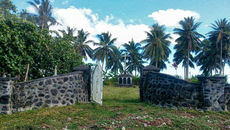
TALES OF TIME - IN MEMORIAM: Safune 1918 & the Day the Dying Began
Around this day – 24 November – 100 years ago the Spanish influenza arrived at Safune, on the island of Savai’i. We can pinpoint this dreadful centenary because of a diary entry kept by a Safune villager, and also from the inscription on a Safune gravestone. {{11575}} The two pieces of writing – one in Samoan and one in German – bear silent witness to the day the dying began, which was a day later, 25 November 1918. The diary entry was made by Mamea Taulaga, at the village of Faletagaloa, in Safune Bay. He wrote a brief observation some time after the dying had stopped and when the survivors had caught their breath and steadied their shattered spirits. Mamea‘s writing, reproduced here and kindly shared by his granddaughter Mrs Tigaina Mamea Aurelio-Laupepa, indicates that Mamea got wind of the coming catastrophe on 17 November when he pens the words that a strange illness, “Fa’amai – Uiga ese”, was abroad. The news might have seeped through to his village on the north coast after the plague arrived elsewhere on Savai’i (it arrived in Apia 10 days earlier on 7 November on board the ship, the Talune). {{11579}} Then Mamea records that the nightmare began in Safune on 25 November when the first deaths occurred. In all, he states, 52 people died in Safune Bay between the small communities of Saletele and Faleolo. One of the first to succumb to the influenza was Mrs Josephine Dāvid (nee Nelson), sister of historical figure Ta’isi O.F. Nelson. {{11583}} She was the 37-year-old wife of Safune trader Mr Felix David, a German settler. She died on 25 November, as evidenced by her gravestone in the family plot at Safune, shown here. Josephine left behind seven children. {{11581}} The epidemic tore through the north coast of Savai’i for about two traumatic weeks. Contemporary newspapers indicate that the total death toll for the Safune district on about 8 December was 112. The Safune district probably stretched from about Safotu in the east to Sāsina in the west. {{11589}} Deaths occurred after 8 December but were declining. Some people who were ailing but in recovery mode also passed on during recuperation in the weeks afterwards. The final death toll for Safune may have been between 120-140. It’s hard to tell. {{11577}} Grief and loss were not the only legacies. Through much of 1919, according to contemporary accounts, food was scarce in Safune and conditions amounted almost to a famine. This was because of the interruption to village planting that the epidemic and the loss of manpower had caused. The photos posted here include some which show Safune several years before it was scarred by the epidemic. {{11585}} {{11587}} Written by Tony Brunt
-
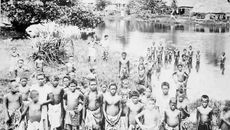
TALES OF TIME - SICKNESS IN THE BOAT
By Michael Field Here is an extract from my work, a small part of the horrific story of influenza in Sāmoa.... In Sāmoa there is a prayer for grace that predates Christianity. ‘This light is for you, O king and gods superior and inferior! If any of you are forgotten do not be angry, this light is for you all. ‘Be propitious to this family; give life to all; and may your presence be prosperity. ‘Let our children be blessed and multiplied. Remove far from us fines and sicknesses. ‘Regard our poverty; and send us food to eat, and cloth to keep us warm. ‘Drive away from us sailing gods, lest they come and cause disease and death. Protect this family by your presence, and may health and long life be given to us all.' Friends and family of those aboard were sitting on boats beside Talune. Tuatagaloa from Faleālili was meeting his daughter: ‘When the doctor was on board the ship and we were lying alongside Talune I heard Falielo, a Sāmoan native call out from the ship, “there is sickness in this boat!” Falielo died in the epidemic. . .When the yellow flag was down I went on board the ship and the first thing l saw was a Sāmoan girl lying in a very weak condition. The name of the girl was Ta‘u. . . . l walked to where the girl was lying on the ship and she could not talk, she was breathing quickly. I saw there were many sick people on board." {{8883}} The warning had been heard by many Sāmoans that morning. Six Ali’i were among those who boarded the ship as soon as it was cleared. Four would be dead within a month. Among those going ashore was the pastor Paul Cane. He was, later he confessed, ‘in a perfect state of prostration’ but Atkinson had not checked him. Cane went straight to the Bank of New Zealand and onward to the trader, Olaf – ‘Fred’ – Nelson. ‘He looked very sick; in fact, he was foaming at the mouth, and his face betrayed the fact he had been suffering from some terrible disease for some time,’ Nelson said. Cane told him he had Spanish influenza. He was taken to hospital and survived. Logan believed that Cane was the agent who spread the virus through Sāmoa. Its highly unlikely that he was the sole agent. {{8885}} Atkinson was called to the Churchward home where Ta’u’s condition was worsening. She complained of a pain in her heart and soon after died. ‘In one or two days there was a family of four including a baby of five months old ill and the baby died,’ he later said. ‘I became a little afraid and wondered if anything had come by the ship. Of course, we knew on opening our mails that it was prevalent in New Zealand and got frightened then.’ {{8902}} Sāmoanische Zeitung editor James Ah Sue had read the mail quickly; ‘With the incoming steamer arrives the news of a serious outbreak of influenza in Auckland, the malady having assumed epidemic form. Mrs George Churchward, who left New Zealand by the last boat intending to make a prolonged stay there, has returned home, having contracted the disease in its milder forms. Another resident of Sāmoa who has returned home as a consequence is Mr John Ah Sue, brother of Jas Ah Sue.’ The 25-year-old died on Monday 11 November 1918. His father died the following month of influenza. Inaction prevented any chance of sparing Savai’i which had it within four days. Logan said the rapid spread resulted from the Sāmoan passengers off Talune going from the ship directly on arrival to villages all over Sāmoa. {{8895}} On Armistice night, crowds gathered on Beach Road to celebrate with a bonfire and burning an effigy of the Kaiser (in Auckland most public gatherings were banned due to influenza). Nelson felt sick during the evening and went home: ‘That was the beginning of an attack which kept me in bed for four months.’ Nelson was to lose his mother, sister, only brother and sister-in-law in the space of six days. He lent his company’s truck to carry the dead to graves. Sāmoanische Zeitung carried reports and family notices which told of the deaths of many senior matai, and their families. W.C. Dean, an old and prominent merchant, died the same day as his adult son. Sam Meredith published a death notice recording the names of seven close relatives. {{8893}} Prominent leader Toleafoa Lagolago notified the death of his mother, brother, two of his sisters, his brother’s wife and a nephew. A fautasi or whale boat came from a village to pick up the body of a matai who had died in Āpia. None of the 17 men who rowed the fautasi returned home; they all died in Āpia. The Fono a Faipule had 31 members when Talune arrived; only seven survived. LMS reported that all but 12 of the 40 members of its Toeaina or Council of Elders had died. More than 100 village pastors and many active lay deacons were dead; ‘In many villages we have lost all our lay workers… just at this crisis when Sāmoans are faced with far reaching political changes they have lost at one fell blow not only all their leading pastors and teachers but the majority of the more experienced and sagacious chiefs, and with them from 20 to 25 percent of the entire population.’ {{8889}} George Westbrook wrote of a young girl staying with his family who went home to visit her father and mother on hearing they were unwell; ‘She chatted with them, and slept between them, and when she woke up in the morning they were both dead.’ An LMS pastor left Āpia to walk along the ‘Upolu north coast, taking up a cash collection for the church. As he went West from Āpia to Mulifanua he spread influenza. Among the first villages afflicted was Vaimoso on the outskirts of Āpia. {{8899}} An eyewitness described one scene: ‘On inspection at this village an appalling state of affairs was disclosed. Every house was closed-up with mats, and inside the gloom the suffering of the inmates was pitiable to behold. Some lay writhing on the ground, some were found covered in mats, sweltering in agony beneath the coverings; others lay in silence. Here and there a sheet of tapa cloth covered a form recumbent and still, indication only too well that the foul disease had finished its work.’ {{8904}} The virus offered some gruesome deaths, noted by John Ryan McLane in Setting a Barricade against the East Wind: Western Polynesia and the 1918 Influenza Pandemic. He described death with cyanosis, the hallmark of severe influenza infection: ‘The lungs filled with fluid, a bloody froth which prevented the transfer of oxygen as the inflammatory pulmonary edema worsened. When patients moved in bed, serous fluid poured from their mouth and nose. A still conscious victim might cough up a litre of pus from their lungs daily, trying to keep the passages clear. Lungs became so full of fluid and silent to auscultation that doctors were convinced their stethoscopes were broken. First the lips and nail-beds of patients darkened, followed by ears, nose, and tongue; finally, further extremities such as the fingers and cheeks lost oxygenation. In some cases, the trunk actually turned an indigo color.’ {{8906}} The pandemic produced many cases, around the world, of people collapsing and dying within hours. Known now as a cytokine storm, it is a drastic immune reaction between cytokine or proteins and white blood cells. In simple terms, particularly in young people, immune systems would overreact to the virus, flooding the lungs with fluid. {{8909}}
-
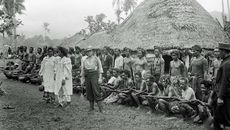
TALES OF TIME - The Samoan War you didn't know about
By Michael Field Since United States independence in 1776, the US and Britain had been mostly hostile toward each other - and in 1812 the two were at war. Easter 2019 marks the 120th anniversary of the first Anglo-American alliance. What is not understood in the South Pacific is that London and Washington united to shell, machine-gun and occupy Sāmoa. Hundreds, perhaps thousands, of Sāmoans, including women and children, were killed by the Anglo-Americans over three months in 1899. It is a story that is not taught in Sāmoa simply because London and Washington were able to divide and arm Sāmoans against themselves. Sāmoa has never had a “king” or “queen”, but in the 19th Century this was an inconvenient fact for colonists who wanted to take the country. Imperial Germany lead the way, but London and Washington quickly followed. Early in 1899, the Anglo-Americans decided a handsome 20-year-old man, just out of school in New Zealand, would be king; the newly appointed tama’āiga Malietoa Tanumafili. {{8840}} Remarkably the Germans preferred tama’āiga Mata’afa Iosefa, a 67-year-old tama’āiga. Eleven years earlier, Mata’afa and his men had ambushed and killed as many as 30 German marines just outside of Āpia, at a place called Vailele. Alliances change though, and Berlin preferred Mata’afa. And so it seemed, did most of Sāmoa; he had a five to one advantage in men under arms over Malietoa. For ‘Upolu, it meant devastating war was to come with hatred on both sides. {{8844}} MATA'AFA GOVERNMENT Despite the naming of Malietoa as king, Mata’afa seized Mulinu’ū and established a “provisional government”. Some fighting between Malietoa and Mata’afa followed and the whites who controlled Āpia called for gunboats. This call led to the arrival of the white hulled German Navy’s Falke was playing the role of a neutral against the Royal Navy’s ships Tauranga, Porpoise and Royalist. Malietoa sought protection aboard Porpoise. The 4324-ton cruiser USS Philadelphia arrived with the US Pacific Squadron Commander-in-Chief Rear Admiral Albert Kautz. {{8834}} As the highest ranked officer in Sāmoa, he assumed command. As an aside, the arrival of the US coincided with the dominance of Admiral Alfred Thayer Mahan’s The Influence of Seapower Upon History that argued empires had flourished not by controlling large land areas, but by ruling the seas. It is why the Americans had annexed Hawaii: Sāmoa was next. Kautz denounced Mata’afa’s ‘provisional government’, calling it ‘revolutionary and subversive of the legal government.…’ Mata’afa was told to go home or be bombed. Mata’afa moved out of Mulinu’ū, not in compliance with Kautz’s demands, but because with warships nearby, his position was indefensible. He went a two kilometres west, across Vaiusu Bay, to set up headquarters at Vaiusu. {{8838}} SHELLING SAMOA At one o’clock on 15 March, Kautz gave the order to open fire. A six inch shell from Philadelphia went over Mulinu’ū and into Vaiusu. Philadelphia’s third shell destroyed a canoe off the village. No record was made of what happened to the people in it. Forty five minutes after firing began, Philadelphia’s salvoes ended. English and American people in Āpia cheered. Other ships then began firing. {{8826}} The shelling alarmed both friend and foe around Āpia when shot fell close to the town. Several men were wounded at the US Consulate. Āpia houses were damaged and riddled with bullets, either by accident or deliberately. At no point that day, or in the weeks to follow, was any attempt made by the Anglo-Americans to account for those they killed and wounded. They were fired ruthlessly into homes along the shore, occupied, for the most part, by women and children. Ashore Anglo-American marines and bluejackets terrorised people with rifle and machine gun fire. Tagoa Coe said officers and soldiers came to the house and told them to get out otherwise they would set it on fire and killed them all; ‘They pushed my mother out with their guns, and we all followed and went on board the German ship.... ‘ The family lost everything. {{8846}} VILLAGES LISTED FOR DESTRUCTION Other places bombarded by the Americans and British that month were Sāluafata and Solosolo. Outside of Āpia harbour in that two week period the US and Royal Navy ships shell and burned the villages of Malie, Fale’ula, Afega, Sāle’imoa, Utuali’i, Faleāsi’u, Vaiusu, Fasito’otai, Falefā, Sāluafata, Solosolo, Sāluafata, Lufilufi,Faleāpuna, Fasito’outa, Leulomoaga and Fagali’i. On 23 March 1899 Malietoa went ashore at Mulinu’ū to be crowned king of that part of the country that the Anglo-Americans let him be ‘under the guns and protection of the English and American fleets.’ British and US ship bands struck up and supporters marched along Mulinu’ū road. Tupua Tamasese Lealofi, a tama’āiga, commanded Malietoa’s army, known as the Red Tops. {{8828}} ‘Understand now you are going to fight for your country and the settlement of good government,’ Ross quoted him addressing his troop. ‘Up to this time these white people have been doing it all for you. Now it is your turn to do something. Go in, never mind what happens, be brave, do not be afraid to get killed. If you are killed good will come out of it, for in time to come even if you are not here your sons and daughters will profit by what you now do.” In an effort to put more fight into the Malietoa side, Lieutenant Guy Gaunt of Porpoise, created an up to thousand strong group to fight. They went near the village of Māgiagi and without warning, opened fire with two heavy machine gun style weapons. One poured 400 shots a minute into the village church. No one checked how many were killed. {{8842}} AMBUSH Mata’afa did not want to fight the whites: he knew they had so much more weapons. But that ended on 1 April, 1899 in what would become the Second Battle of Vailele. The Anglo-Americans marched over to Fagali’i and destroyed the village. They moved on and destroyed Vailele and Letogo villages. With that they decided to march back to Āpia. Between the Vaivase stream and Faleālili Street Mata’afa ambushed the Americans and the British. The foreigners suffered a resounding battlefield defeat, with many killed. {{8836}} The Anglo-Americans fled the battlefield and Mata’afa achieved the globally unique moment of having beaten the Germans, the Americans and the British in battle. A monument was erected at Mulinu’ū honouring the Anglo-American dead. There are no monuments to any Sāmoans; it’s not even known how many were killed. Even the voices of those who were there, fighting for Mata’afa, went silent and then were lost in a tragedy 18 years on. {{8824}} HIGH EXPLOSIVES ON VAILIMA The shelling and destruction of villages continued. HMS Tauranga threw experimental ‘lyddite’ shells at Vailima. Each shell contained a powerful chemical explosive, stronger than dynamite. From 1896, they were the first of Britain’s high explosive shells. Their big moment would come in the Great War ahead. ‘The Stevenson residence was found in ruins and there were evidences of a fearful slaughter Gaunt, with a woman, Tulia, beside him. She was said to be a water carrier. The Red tops lost 10 men with 17 wounded. The Stevenson house had a German flag flying over it. When Gault captured it, the flag was ‘handed to the tāupou, or village belle…,’ Tulia. {{8850}} The world came to be shocked at what the British and Americans were doing. The strongest attack came from Fanny V de G. Stevenson, widow of the novelist: ‘the exodus of the panic-stricken non-combatants rushing hither and thither; shells bursting everywhere; the cries of the bed ridden and the helplessly wounded burning alive in their blazing hours; women in the pangs of childbirth (for Nature takes no count of bombardments); mangled children crawling on the sands - the sea before them, the bush behind them; and we read that the woods also are shelled. Who is to be held accountable for those deeds that disgrace both England and America?’ Australian Catholic Cardinal Patrick Moran said what was happening was not warfare, but deliberate murder. America was bent on making the Pacific a new American lake. He looked upon this as very dangerous, not only to the natives of islands in the Pacific, but to the British Empire. It was clear to him Americans fermented the disturbances to suite their own ends, Moran said. The Catholic journal les Missions Catholiques called it all a ‘cruel and ridiculous spectacle of two great powers, the United States and England, with all the resources of modern artillery, uniting their forces to give battle to some handfuls of natives. During two months their ships discharged more than a thousand shells into the villages of Upolu.’ {{8832}} The news of battle did not deter New Zealand: Prime Minister Richard John Seddon volunteered to send New Zealand soldiers to help the Anglo-Americans. Through April the attacks on villages continued: Papasē’ea, Utumau’u, Fagaloa and Fālifā. SAMOA DIVIDED Eventually the three powers decided Sāmoa began to believe it was not worth the coin and decided to send a trilateral commission out to effectively divide up the Pacific. No one in Sāmoa was asked their opinion. The commission arrived on a US cruiser. The American commissioner, Bartlett Tripp, wrote a moving book on it all. He told of when Mata’afa arrived at the cruiser for talks: ‘Mataafa was clad in a long white robe which came down to his feet and was partially gathered at the waist by some form of belt but flowing somewhat loosely about his large stalwart form, giving him, with his dignified mien and presence, something of the appearance of a Roman Senator. His head and feet were bare, and he wore no ornaments of any kind except a necklace of beads and a cross, the emblems of his church.’ The talks between Mata’afa and Malietoa are the stuff of movies; the very best of fa’a Sāmoa on display. Both sides agreed to surrender their weapons. All Sāmoans were betrayed, of course. {{8848}} The true death toll in the civil war was never known; no authority ever tried to establish it. There are monuments to dead white people killed in the conflict in several countries; none to the Sāmoans. A century later, the loss of so much life is unaccountable. The soldiers and sailors who died were just players in a vague colonial sideshow; no one in the colonial capitals were prepared to escalate the conflict into a full-scale war. In a lightweight Treaty of Westphalia, diplomats seriously considered tossing sovereigns, dollars or marks into the air to decide on the division. {{8852}} Kaiser Wilhelm wanted ‘Upolu because German blood had been lost there.’ Pago Pago appealed to him. In the dealing, he offered London possession of Savai’i, Tonga and Niue. Germany would withdraw from Zanzibar or the English part of New Guinea or the Solomon Islands. German planters worried about giving up the Solomons as it was a labour source. It was bookkeeping on a global scale with bits of land in the Volta Triangle and the Yendi part of the Neutral Zone in West Africa. The Americans were determined to keep Tutuila, not least because of Pago Pago. AN INTERNATIONAL CRIME Malietoa believed the deal was a ‘crime against the law of nations, only equal to the dismemberment of Poland, Denmark, and France’. He blamed missionaries, missionaries ‘with their holy or unholy presence introduced the same religious differences and hatreds against each other as pertained at the hour in civilized States. The missionaries live in palatial, concrete houses, with all the luxuries their countries can afford, and charge us for Bibles and Prayer Books, which we understand are sent as free offerings.’ There are monuments to the dead Americans and British in Washington DC, Spokane, Washington, California and Mulinu’ū - just down the road from the old Fale Fono. {{8821}} There are no monuments to the Sāmoan dead. Nor is there a day set aside in Sāmoa to recall the terrible disaster. Later in April, Sāmoa will however pause and recall the deaths of Australians and New Zealanders - somewhere else. Time to change this?
-
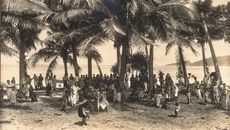
TALES OF TIME: ALEIPATA – Where Samoans Overthrew Outside Rule circa 1250 A.D.
In about 1250 A.D. – nearly 800 years ago – the Samoans staged a surprise armed rebellion against rulers from Tonga somewhere on the brief stretch of coastline shown in the first black & white photo (above) behind the canoe. The short, violent campaign that followed the attack brought to an end about 300 years of Tongan control of Upolu and Savai’i and saw the creation of the crucial Samoan ‘Tama-a-‘Aiga’ title of Malietoa. Historic places do not receive much official attention in Samoa, and the Aleipata coastline, which is only a few kilometres long, has no marker or retained knowledge about exactly where the ambush of the Tongan ruler Tala’aifei’i and his escort took place. However, the likelihood is that it was between Satitoa on the left of the photo and Mutiatele on the right, not much more than a kilometre in distance. {{8597}} The villages in this stretch are Satitoa, Malaela, where my grandmother came from, Lotopu'e and Mutiatele. This road along the shore is known nowadays mainly as a picturesque route to the nearby tourist destination of Lalomanu but its importance in Samoan culture and folklore can be gauged from the fact that the broad details of the Aleipata ambush were handed down for hundreds of years by word of mouth until European historians and ethnologists wrote the account down in the 19th century. They used the yardstick of 25 years = one generation to work back to the timing of the rebellion which occurred 25 generations beforehand i.e. around the year 1250. My family connection to this locality has provided me with a feeble excuse to tell the story of the overthrow and suggest more recognition for this locality’s historical importance. Here are some old photos from private collections which I’ve combined with captions to describe this turning point in Samoan history. My apologies to my Tongan friends for raking over cold ashes with this account of a rather brutal but pivotal affair but it’s a story which is not often told from a geographical angle and deserves recounting with pictorial support. One could argue that Aleipata’s claim to historical fame deserves to elevate it to a similar lofty status as currently enjoyed by the likes of, say, Falealupo and Vailima. {{8595}} The 3 centuries or so of Tongan rule apparently began with conquest by Tongan historical figure Asoaitu. Relative harmony prevailed afterwards and no serious resistance arose until the hard rule of Tala'aifei'i began. His cruelty provoked plans for a rebellion by two proven young warriors of Faleata, near Apia, named Tuna and Fata. {{8599}} There are 2 versions of how the brothers and their supporters planned the attack on Tala’aifei’i and his Tongan camp followers. One story has it that they rallied island-wide support for the rebellion which was pre-planned to occur on the Tongan king’s birthday celebrations to be held ‘at the malae of Aleipata’ two months after the plot was hatched The other version has Tuna and Fata journeying with their warriors to overtake the king’s travelling party which occurred on the Aleipata coast. Weapons were hidden and some of the men joined in the peaceful feasting and celebrations. {{8601}} A few notes of the famous Tongan siva, Matamatamé, sounded as the dancing began and this was the pre-arranged signal for the ambush. Samoan’s charged from nearby forest. One version has the unarmed Samoan dancers using their feet during the siva to kick away the sand from buried clubs. In any case, a great, one-sided battle occurred, with the figure of 200 of the king’s party quickly killed being mentioned in historical accounts. {{8603}} My cousin, the late Luamanuvae Pa'ipa’i Schwenke, of Malaela, the large man on the right behind the kerosene lamp told me that human bones were often to be found in the sand on or near the beach around Malaela and just north around Pué. He believed these were from Tongans who had been killed in the fight. Asipau Tafua says that Malaela (‘field of the sun’) was named because it was a sunny spot and was known as the field where the bodies were laid out in the sun following the fighting. Asipau, whose forbears hail from Malaela, says that no one who knew the history of this haunted strip of land would live on it until unsuperstitious Irishman, Ned Purcell, bought it and settled there with his Samoan wife in the mid-1800’s. {{8605}} Tala’aifei’i escaped the conflict and fled towards Mulifanua at the other end of Upolu where his vaka were moored. Fata and his nephew the warrior Ulumasui led the pursuit of Tongans south around Lalomanu and along the south coast shown in the photo. {{8607}} Others in the king’s party were chased along the north coast by Tuna and Tapuola, a chief of Aleipata. Historical accounts do not mention which route Tala’aifei’i took. {{8609}} Tala’aifei’i and some of his men reached their vaka at Nu’usagale, near Mulifanua, and left for Tonga but not before the Tongan leader delivered a generous oration to Tuna and Fata as he stood on a rock ever since known as Tulutalā: ‘Malie toa, malie tau! Afai e o’o mai Tonga, e sau i le Aouiuli folau, ae lē sau i e aouliuli tau.’ ‘Brave, warrior, bravely have you fought! If the Tongans ever come back, it will be for a friendly visit, but never again to fight you.’ The Malietoa title derives from the first words of the speech by Tala’aifei’i. Though Tuna and Fata had been the leaders of the rebellion, one story has it that violent bickering between the two led to the first Malietoa title being bestowed on their older brother Savea. Another version has the brothers giving the first Malietoa title to Ulumasui in gratitude for his part in the overthrow.
-
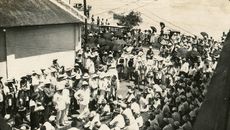
TALES OF TIME: An Arresting Day in Samoan History - 24 February 1928
A traumatic incident in Samoan history occurred on 24 February 1928 when 400 members of the protest movement, the Mau, were arrested on Beach Rd, in Apia, in a round-up by marines from the Royal Navy who had been called in by a panicky New Zealand Administration. {{6024}} The Mau had been pressuring the administration and its supporters for concessions on a greater degree of self-government by enforcing a boycott by Samoans of Beach Rd stores. The Administrator, General George Richardson, had urged “…force here at once,” in a telegram to NZ. The cruisers ‘HMS Dunedin’ and ‘HMS Diomede’ were despatched to provide armed manpower. {{6026}} “At 9 a.m. on 24 February,” writes author Michael Field, in his book on the Mau, “landing parties of marines and naval officers headed out from the cruisers to the Customs and Tivoli wharves in a pincer movement to round up the 400 Mau on Beach Rd. Somewhat surprisingly, given Richardson’s panic stricken messages, the Mau were ‘docile’ and made not the slightest attempt to resist arrest.” {{6028}} The men were corralled into a lane at the eastern end of town which separated the Alcazar Garage and the LMS Mission building, from whose balcony a few of these pictures were taken. A line of lorries and trucks were ordered in to take the men to the Vaimea Prison, a departure for captivity that seems to have been marked by a carnival atmosphere. {{6030}} The Vaimea jail predictably proved inadequate for the numbers arrested and a temporary camp was set up at Mulinu’u, which also proved impossible to guard effectively. Many men went round the barbed wire and walked through the water at low tide to attend to their personal affairs or kill time in town. Michael Field wrote: “The Mau often went to the movies in the evening in Apia and [Naval Commodore George] Swabey told of one of his officers finding a chief weeping because he had been stopped by the marines from going out to the pictures. ‘A curious people,’ Swabey commented, ‘hard to understand.’” {{6032}} Two weeks after the Beach Rd round-up a bamboozled NZ Administration threw in the towel. Administrator Richardson remitted all the prison sentences (6 months) and the men were released. {{6034}}
-
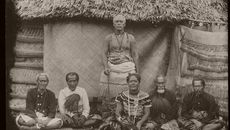
TALES OF TIME: 19th Century Colonial Samoa
Thomas Andrew (1855 – 1939) was a New Zealand photographer who lived in Samoa. Andrew took photographs that are of significant historical and cultural value including the recording on camera of key events in Samoa’s colonial era such as the Mau movement, the volcanic eruption of Mt Matavanu (1905–1911) and the funeral of writer Robert Louis Stevenson. Many of his surviving images are held in the collections of the Museum of New Zealand Te Papa Tongarewa and include landscapes and studio portraits of Samoans that went beyond the colonial stereotypes of the time. {{5589}} {{5591}} {{5593}} {{5595}} {{5597}} {{5599}} {{5601}} {{5603}} {{5605}} {{5607}}
-
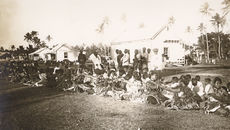
TALES OF TIME: Major Cultural Performance in Ha'apai, Tonga circa 1913-1914
A number of photos of dancing performances at Ha’apai in Tonga from around 1913-14 have recently become available. These may not have been seen before and are from a collection donated to the Museum of Samoa in 2016 by Mrs Gesa Akkerman-Ohle, granddaughter of a former German businessman in Samoa, Mr Karl Hanssen. Mr Hanssen labelled these photos, ‘Ta’alolo, Haabai,’ referring to a Samoan ceremonial parade and presentation. This major event is on such a scale that it may have been attended by the Tongan monarch, King George Tupou II. The first two photos show men wearing hats and wielding clubs in a version of the Tongan war dance, the Kailao. Others show women sitting down performing the Samoan Ma’ulu’ulu, which is popular in Tonga. Men and women are also shown doing the Lakalaka. {{5354}} {{5357}} {{5360}} {{5362}}
-
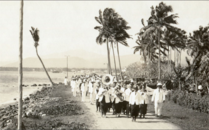
TALES OF TIME: The German Commemoration Service, 03 July 1932
On Sunday 3 July, 1932, the last of the German settlers and their Samoan descendants, more than 400 people, marched to the newly renovated German monument at Mulinu’u, in Apia, for a commemoration service and laying of wreaths. The Apia Brass Band led the way, playing an old German cavalry march, “Drei Lilien.” Source: germansinsamoa It was in many ways the last great occasion of the German settlement of Samoa. Within a few years many of the ‘Old Identities’ of the German community had passed on. They rubbed shoulders at Mulinu’u one last time as “O le taimi o Siamani” (“the German Time”) faded into memory. Credit: Spemann Family Collection. The blending of the German and Samoan peoples was apparent in the marchers that day. By the time of the monument ceremony three generations of German-Samoan descendants had emerged in some families. Credit: Spemann Family Collection. Apia architect Mr Albert Schaaffhausen (3rd from right holding wreath) had spent several months of voluntary labour renewing the foundation, fence and monument before the ceremony. He was the architect for many of Samoa’s most notable colonial buildings during the German administration of 1900-1914. The accomplished builder of many of Schaaffhausen’s landmarks, Mr Friedrich ‘Fritz’ Stunzner, is also in the picture (3rd from left with white beard). Others that can be identified (left-to-right): Boy in shorts Max Grapengiesser Jnr; 4th from left with glasses Mr Max Grapengiesser Snr, a plantation manager from Tuanaimato; Mrs Hedwig Grapengiesser (nee Gebauer) dark hat, partly obscured; Mr Arno Max Gurau; Mrs Else Klinkmuller behind; Mr Rudolf Gebauer, a planter at Aleisa; Miss Gertrude ‘Trude’ Stunzner behind; Mr Augustus Betham, dark jacket. Credit: Grapengiesser Family Collection; photographer A.J.Tattersall; restored by T.Brunt 2013. The people in this photo are (left-to-right): Mrs Mary Meiritz (at rear); Miss Elfriede Meiritz (in front); Mr Emil Meiritz (looking down), a planter and transport operator from Mulifanua; Mr Cyril ‘Mac’ McKay (standing behind), of the NZ Administration; Mrs Fa’auiga Meyer (?); Mrs Moe Carruthers; Mrs Else Klinkmuller (with bag); Miss ‘Trude’ Stunzner; Mrs Louisa Sasse (nee Hellesoe) behind; Mr ‘Fritz’ Stunzner; his son ‘Fritz’ Stunzner Jnr; Mrs Mary Ellen Stunzner (nee Betham) with dark hat; Mr Augustus Betham (dark jacket); Mr Wilhelm Arp partly obscured; Mrs Hedwig Grapengiesser; NZ Administrator, Brigadier General Herbert Hart; Mr Max Grapengiesser Snr at rear (glasses and grey hat); Mr Arno Max Gurau at rear (grey hat); Commander Ramsbottom of the HMS Laburnum; Mr Fritz Jahnke (grey hat), a planter at Mulifanua; Mrs Theresia ‘Tupou’ Jahnke; and their daughters Marie ‘Maria’ Elise and Gertrude. Credit: Klinkmuller Family Collection; restored by T.Brunt 2013. Four interesting new people appear in this photo from the 1932 gathering, all on the right hand side. Apia lawyer and former German administration official, Mr Gustav Klinkmuller, who arrived in Samoa in 1906, holds his hat in his hands. On his right is Deputy NZ Administrator, Mr Alfred Turnbull, who succeeded to the top position in 1935. In the dark suit is Mr Manuel de Silva, of Portuguese-Samoan descent, who saved 16 German sailors during the hurricane of 1889 in which the Germany Navy lost two ships and 93 men in Apia Harbour. Their deaths were some of those commemorated on the German monument. Next to him in the dark hat and tie is Pastor Raimund Reye, Superintendent of the Seventh Day Adventist Mission, who gave the opening address at the ceremony. He was the Samoan-born son of Mr Ernst Friedrich Reye and Mrs Margaretta Reye (nee Betham). The 29-year-old Reye spoke in German at the German monument, in English at a second ceremony at the Anglo-American Monument, and in Samoan beside the Samoan graves nearby. His eloquence in all three languages “won golden opinions from everybody,” according to a report in the Samoa Herald. Main Photo Credit: Klinkmuller Family Collection.
-
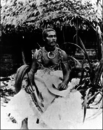
TALES OF TIME: Tui Manu'a Empire of Samoa
It is appropriate to address the topic of the Oceania empire of the prehistoric Tui Manu’a and the extent to which this influence permeated the social-political sphere of Samoa and Tonga at that time. Prior to and during the rise of the great familial titles of Savaii, Upolu and Tongatapu, the Tui Manu’a was the highest ranking title and office of all Samoa, Tonga and various other islands. Source: Samoa History The Tui Manu’a Kings extended Samoan influence and rule over various island groups including Tonga and parts of Fiji in which all of these islands payed tribute to Tui Manu’a Kings called Umiti. Oral traditions coupled with cultural, linguistic, and archaeological evidences suggest that Samoan influence and rule was at one time or another felt throughout all of Tonga, the Niuas/Niue, the Marquesas, parts of Fiji, Rotuma, the Cook Islands, Uvea, Futuna, Tokelau, and Rurutu. Polynesian outlier groups located outside of the Polynesian triangle are also linked to ancient Samoan voyaging and cultural diffusion. The Tui Manu’a Empire was referred to in Samoan lore as the Manuatele (Great Manua) and the Faleselau (House of Hundreds). The latter title referred to the hundreds of islands within the Tui Manua’s sphere of influence and rule. The Great Manu’a is mentioned as Manuatere in Eastern Polynesia and as Manuka in Tongan and Cook Islands. Archaeological evidence suggests that these early tributary networks may have been based around the distribution of certain prestige goods such as basalt adzes (toi maa or matau) and obsidian (volcanic glass). Samoan adzes from Tutuila were anciently exported as far away as Mangaia in the Cook Islands and that basalt artifacts were being continuously imported from Tutuila to Manua for about 3,000 years. Samoan-made stone tools had also been prehistorically distributed to Tonga and Fiji, Pukapuka and Rarotonga, and polities as far off as Anuta, the Solomon Islands, Tikopia, and Pohnpei. The Tui Manua kings grew powerful not only through WAR but by controlling and regulating interisland exchange networks from the commercial hub they had established in Manu’a and their empire was probably more expansive in scope than that of the later and younger Tui Tonga Line. The Tui Manu’a empire confederacy had similarly taken the place of an even earlier maritime chiefdom which was ruled by the Tui Pulotu kings of Fiji. It is very likely that the growing autonomy of the Tongan and Samoan constituencies led to the demise of the Tui Pulotu federation and similar uprisings probably caused the weakening of the Tui Manua’s influence as well. The decline of Manuatele allowed for greater self-determination throughout the southwestern Pacific and it seems the Tui Tonga dynasty makes its first appearance during this period. (SEE BELOW) TONGA ANCIENT TONGA CONSISTED OF ONLY 1 ROYAL LINE 1) Tui Tonga * Over time and space, Tongan society became more settled, shaped strictly by both internal pressure and external influences. The external influences came in the form of imperial activities beginning with the Tu’i Pulotu empire in Fiji and followed by the Tu’i Manu’a empire in Samoa. In other words, Tonga was under considerable influence from the imperialism of both Fiji and Samoa. However, Tonga was able to free herself through bitter and bloody wars from the imperial domination of the Tu’i Manu’a — which eventually led to the formation of the Tu’i Tonga empire around AD 950 in the person of ‘Aho’eitu, the first Tu’i Tonga — whose father was a deified Samoan high chief, Tangaloa ‘Eitumâtupu’a, and mother a Tongan woman, Va’epopua, of great noble birth. This double origin, entitled the Tu’i Tonga to hold both divine and secular offices. In principle, the close cultural and historical interlinkages between Fiji, Samoa and Tonga were essentially elitist, involving the intermarriage between regional aristocratic families. Na’e hoko e ngaahi liliu lahi ‘i Tonga ni tupu mei he’ene fetu’utaki mo muli, ‘o kau e kakai mulimo ‘enau sivilaise ki hono fakalele ‘a e fonua. Na’e fuofua nofo’i ‘a Tonga ni ‘e he kau Pulotu, ‘aia koha kau muli ‘oku ui ‘e he ‘akiolosia ko e kau Lapita. Na’e pule’i fefeka ‘a Tonga ‘e he Tu’i Manu’a, ‘o hu mei Ha’amoa mo Polinisia hahake ha ngaahi fetu’utaki ne ‘asi ‘i Tonga ko e ngaahi ‘Otua mo tangata, taula’eiki mo e Tu’i, ‘Eiki mo e Hau. Na’e tu’uloa ‘a e tufunga fonua ‘a e muli ko Lo’au mo e Tu’i Tonga, ‘a ia na’e fokotu’utu’u fo’ou ma’u pe mafai ke hoa mo e liliu he fonua, ‘o hange ko ‘ene ‘asi he ngaue tu’uloa mo tolonga ‘a Tu’itatui mo Kau’ulufonua I. Na’e tatau ‘eni mo hono fa’u e sino fakapolitikale muli ko e Konisitutone ‘e Taufa’ahau mo Misa Peika, ko ha Papalangi, ‘o ‘ikai kehe ia mei he hake mai ‘a e ngaahi tui muli ko e lotu faka-Kalisitiane, ako mo e temokalati. * Hundreds of years later after the establishment of Ahoeitu in Tonga, the 15th Tui Tonga Talakaifaiki became a paramount Chief in Savaii. His Chiefdom in Savaii was short lived for he was defeated and expelled from Samoa by Tuna & Fata which lead to the creation of a new title & dynasty known as MALIETOA. * In the late 1400’s early 1500’s a new Royal line was finally created in Tonga, known as the Tui Ha’atakalaua Line. Then in the 1600’s the Tui Kanokupolu (Flesh/Heart Of Upolu) royal line was established. The Tui Kanokupolu royal line has similar origins to that of the Tui Tonga Line. Both the Tui Tonga Line and Tui Kanokupolu Line have Samoan Origins as stated by the King of Tonga, George Taufa’ahau Tupou 1. (See Below) * The Tui Kanokupolu (Flesh/Heart Of Upolu) Line are the current rulers of Tonga. SAMOA ANCIENT SAMOA ORIGINALLY CONSISTED OF ONLY 3 ROYAL LINES: 1) Tui Manu’a Ma Samoa Atoa (HEAD) 2) Tui Atua 3) Tui A’ana This was the era of Tagaloalagi and the TUI titles. During this ERA the SEAT OF POWER of all Samoa was the Manu’a Islands and the head was TUI MANU’A MA SAMOA ATOA. Hundreds of years later a new era of non TUI’s began in Samoa such as the newly established Malietoa, Gatoaitele, Tamasoali’i, Tonumaipe’a and Le Tagaloa Lines. When the non TUI families rose to power a new political system was formed and established known as the TAFA’IFA when this happened it marked a power shift in Samoan History. The original SEAT OF POWER of Samoa shifted from Tui Manu’a and the Manu’a Islands in the EAST to the Tupu Tafa’ifa of UPOLU & SAVAII Islands of the WEST. Tui Manu’a Ma Samoa Atoa no longer had political influence in Upolu or Savaii but was still recognized as being of the highest prestige in rank. SAMOA INFLUENCE IN POLYNESIA Gilbertese genesis legends claim initial colonization from Samoa and tell of regular voyaging between Samoa and the Kiribati islands. Samoan canoes introduced Samoan traits into prehistoric Anuta. The dialects of Tikopia, Pukapuka, Uvea, Tuvalu, Nukuoro, Kapingamarangi, Nukumanu, and Sikaina are all considered Samoic languages because they originated from or were heavily influenced by Samoa in prehistory. (SEE BELOW) SAMOIC LANGUAGES – ISLANDS WHO ORIGINATED FROM OR WERE HEAVILY INFLUENCED BY THE MOA FAMILY OR SA(MOA) IN PREHISTORY * East Uvean-Niuafo’ou o Niuafo’ou (Nuiafo’ou , in Tonga) o Wallisian or Uvean (Wallis (Uvea) in Wallis and Futuna) * Ellicean o Tuvaluan (Tuvalu) o Kapingamarangi (Kapingamarangi in the Federated States of Micronesia) o Nukuoro (Nukuoro in the Federated States of Micronesia) o Ontong Java (Ontong Java in the Solomon Islands) o Sikaiana (Sikaiana in the Solomon Islands) o Takuu (Takuu in the eastern islands of Papua New Guinea) o Nukumanu (Nukumanu in the eastern islands of Papua New Guinea) o Nuguria (Nuguria in the eastern islands of Papua New Guinea) * Futunic o Anuta (Anuta in the Solomon Islands) o East Futunan (Futuna in Wallis and Futuna) o West Futunan or Futuna-Aniwa (Futuna and Aniwa in Melanesian New Caledonia) o Emae (Emae in Vanuatu) o Rennell (Rennell in the Solomon Islands) o Mele-Fila (Mele in Vanuatu) o Pileni (Pileni in the Solomon Islands) o Tikopia (Tikopia in the Solomon Islands) o West Uvean (Western Uvea , New Caledonia) * Pukapukan o Pukapukan (Pukapuka in the Cook Islands) * Samoan o Samoan (Samoa and American Samoa) * Tokelauan o Tokelauan (Tokelau, a dependency of New Zealand) * Niuatoputapu o Niuatoputapu (Niuatoputapu in Tonga) * The Manu’a Islands were the original HEADQUARTERS of the SA TAGALOA Clan hence Manu’a were considered sacred islands (MOTU SA) to all Samoa and Tonga. The sacred Chant, “TUI MANU’A LOU ALI’I E”, was once chanted in Tonga, Tahiti and other islands of Polynesia to honor the mysticism of royalty to the title. Still today the Tui Manu’a Chant can be heard in Samoa but only on special occasions. “O ou paia ia Samoa e afua mai ile taisamasama ole Tui Manu’a seia paia le fafa o saualii”. TUI MANU’A LIST OF KINGS: SOURCE: (Tui Manu’a Salofi Son) (Misilao Moliga) (Galea’i Lilomaiava) (Taule’ale’a Moliga) NOTE: The Family Lineage of Tui Manu’a Kings starts with the ancient Tagaloa and Moa Clans. In Manu’a, the ‘Moa’ title became synonymous with the Tui Manu’a title because the Moa family along with the Tagaloa Family were the ancestors of the Tui Manu’a Line. * There may be more Tui Manu’a Kings then listed below 01) Tui Manu’a Satiailemoa 02) Tui Manu’a Tele or Fitiaumua 03) Tui Manu’a Maugaotele 04) Tui Manu’a Tae O Tagaloa or Folasa 05) Tui Manu’a Fa’aeanu’u or Fa’atutupunu’u 06) Tui Manu’a Saoioiomanu 07) Tui Manu’a Saopu’u 08) Tui Manu’a Saoloa 09) Tui Manu’a Tu’ufesoa 10) Tui Manu’a Letupua 11) Tui Manu’a Saofolau 12) Tui Manu’a Saoluaga 13) Tui Manu’a Lelologatele 14) Tui Manu’a Alia Matua 15) Tui Manu’a Alia Tama 16) Tui Manu’a Ti’aligo 17) Tui Manu’a Fa’aeanu’u II 18) Tui Manu’a Puipuipo 19) Tui Manu’a Siliaivao 20) Tui Manu’a Manufili 21) Tui Manu’a Fa’atoalia Manu-O-Le-Fale-Tolu 22) Tui Manu’a Segisegi 23) Tui Manu’a Siliave 24) Tui Manu’a Pomelea 25) Tui Manu’a Lite or Tui Aitu 26) Tui Manu’a Toalepa’i 27) Tui Manu’a Seuea 28) Tui Manu’a Salofi 29) Tui Manu’a Levaomana or Lemamana 30) Tui Manu’a Taliutafa Pule 31) Tui Manu’a Ta’alolomanu Moaatoa 32) Tui Manu’a Tupalo 33) Tui Manu’a Seiuli 34) Tui Manu’a U’uolelaoa 35) Tui Manu’a Fagaese 36) Tui Manu’a Tauveve 37) Tui Manu’a Tauilima 38) Tui Manu’a Alalamua 39) Tui Manu’a Makerita 40) Tui Manu’a Elisala – Officially the last Tui Manu’a who died in 1909 41) Tui Manu’a Kilisi Taliutafa – Revived the Tui Manu’a title in 1924 but never fully took office.
-
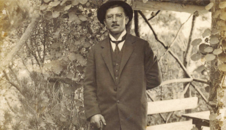
TALES OF TIME: Rudolf 'Pakigi' Berking
Berking served the german government of samoa and then lived on to see the arrival of the nation’s self-government in 1962. Source: germansinsamoa It was no surprise that one of the five men who organised the Mulinu’u ceremony was Mr Rudolf Berking. You won’t find much mention of him in the history books of Samoa but he was arguably the most prominent German Samoan of the 20th century. He never held high office and his life was marked by dislocation and adversity, but Rudolf Berking was a generous and public spirited man who commanded broad community respect. He outlived all his German contemporaries, dying in Apia in 1972 at the age of 92. Berking had served in the German government of Samoa and then lived on to see the arrival of the nation’s self-government in 1962. Independence for the Samoans must have seemed impossibly distant in the horse-and-buggy days at the turn of the century when Berking stepped off his ship. Credit: Klaus Berking Collection. Credit: “Cyclopedia of Samoa,” McCarron, Stewart & Co, Sydney, 1907. Rudolf Berking was born in Hanover, Germany, and arrived in Samoa in 1900 via Hawaii. After a stint in junior roles in the Customs Department he was made Collector of Customs in 1905. In this photo from the Cyclopedia of Samoa, 1907, Berking can be seen standing in white at the entrance to the Customs House, on the Apia shoreline. His assistant C. Pullack appears to be on the left and the “tide-waiter”, Captain F.Kruse, on the right. The Cyclopedia commented on a personal quality of Berking that had made him popular in his Customs role and for which he was known throughout his life: a great courtesy and thoughtfulness of manner. Credit: Agnes Sasse Heeney Collection. This photograph was taken in about 1913-14 of a group of people partying, reportedly at the holiday home of Mr Berking and his wife at the time, Mrs Caroline Berking (nee Netzler), at Letogo east of Apia. With a few exceptions most of the men in the photo appear to be Germans drawn from Apia’s commercial community, especially the large trading and plantation company, DH & PG (Deutsche Handels und Plantagen Gesellschaft der Südsee Inseln zu Hamburg). A number of people can be identified: man at top in middle holding up a glass of beer, Mr Ludwig K.Schmidt; man second row from top on the left leaning on handrail, Mr Werner Sasse; woman beside him in long white dress, Mrs Caroline Berking; other woman with hand on handrail, Mrs Antonie Schmidt; man sitting on step with hand on chin, Mr Rudolf Berking; next row down, sitting on the bottom step, left-to-right Mary Swann, Margaret (Maggie) Swann, Mr Peter Fabricius and Agnes Swann (later hotelier Aggie Grey). Mr Fabricius married Margaret Swann in October 1913. He was of Danish descent. Credit: Alfred Schultz Album; photographer R.Hofmann; restored by T.Brunt 2013. After the outbreak of the First World War in 1914 and the end of German rule, Rudolf Berking staved off internment for some months teaching New Zealand officials how to run the Customs Department. In the chaos of a new administration “disorder reigned in all government departments,” he wrote later. Working without pay, “I was at the disposal of Colonel Logan and his Customs officers at any time of the day or the night.” Despite his close cooperation with the occupying forces Berking was shipped out of Apia in May 1916 to become “Prisoner of War No. 63” in the New Zealand internment system. This photo shows him working in the kitchen at the camp on Motuihe Island, Auckland. People identifiable in the photo (left-to-right) appear to be: Wilhelm Osbahr, Berking, Max Bartel, Alfred Schultz, Brenner, Dr Endletsberger (with pipe), Arthur Gardain, others unknown apart from far right, sitting, Wilhelm Holzeit, formerly an accountant at Krause & Preuss, Apia. Credit: Tony Brunt Collection. Caroline Berking, shown in the middle, suffered from persistent ill health during her husband’s absence in New Zealand. Maintaining the family’s 140-acre plantation at Letogo was a struggle. Eleven Chinese workers were employed on the property but there was no money for an overseer – Caroline had to fulfill that role herself. She was also alone with no children to lend a hand. A daughter Ernestine had died some years before. Her two surviving children, daughter Elisabeth ‘Lissy’ (born 1902) and son Rudolf (born 1903) were both at school in Germany. This photo shows Caroline with a young man who may be her half brother Augustino, whom she adopted, and a niece. Credit: Klaus Berking Collection. A photo of the Berking children, Lissy and Rudi, (at back) taken with a relative in Germany during the war, in about 1916. Their upkeep at school was paid for out of their father’s government salary which appears to have continued to be paid. Mr Berking’s salary also supported his mother in Hannover. Sending children to Germany for education and work was popular with German fathers in Samoa. Caroline and Rudolf Berking paid a terrible price for their understandable desire for a better education for their offspring in distant Europe. In September 1918, Elisabeth died of pneumonia in Hannover aged 16. Wartime internment for Rudolf meant that the parents had to cope with their grief apart. In 1926, another tragic blow – son Rudolf fell ill and died while attending veterinary school in Berlin. Credit: Alfred Schultz Album; photographer R.Hofmann; restored by T.Brunt 2013. Rudolf Berking took a leadership role in 1919 when approval for repatriation of the POWs back to the islands was bogged down in post-war red tape. He pleaded time and again with the military authorities to allow the married men especially, to return to their families. His submissions were signed, “R.P. Berking for this camp.” Finally, the Treaty of Versailles was signed and the Allies got clarity on what they could do with German POW’s and assets. Berking took passage for Samoa in February 1920. Nearly four years of captivity had come to an end. In this last photo of Berking from Motuihe he is standing in the middle wearing a white pith helmet. The others (left-to-right) are: Mr A. Ohle (DH & PG, Tonga); Mr Wilhelm Holzeit; Mr Alfred Schultz; Berking; Count Felix von Luckner; young boys Kurt Stunzner and Fritz Stunzner Jnr, who lived for a time on the island with their parents in self-contained accommodation; Mr R.Hofmann. Credit: Reye Family Collection A willingness to accept responsibility and a strong loyalty to the country of his birth saw Rudolf Berking take a leading role in advancing German interests in Samoa and attending to the welfare of Samoa’s remaining German citizens and their families. The number of Germans in Samoa had shrunk by about three-quarters after the post-war repatriations to Germany in 1919, and the forced deportation of nearly 200 Germans (including children) by the NZ administration in Samoa in June 1920. This photo shows Berking as the leading pallbearer at a major turn-out of Germans and other citizens at Magiagi Cemetery, in Apia, in August 1933 at the burial of Mr Ernst Friedrich Reye, long-time Apia resident and former personal assistant to German Governors Solf and Schultz. Others in the photo (left-to-right) are Mr Robert Wetzell, Mr Augustus Betham (dark jacket), Mr Friedrich ‘Fritz’ Stunzner, Mr John Netzler and in the white suit Mr Raimund Reye. Credit: Meiritz Reid Family Collection. In February 1934, Mr and Mrs Berking hosted a reception for the crew of the visiting German Navy cruiser Karlsruhe at their property at Letogo. Rudolf had remarried in 1931 to Anna Lefagaoali’i (nee Saffings). She can be seen, third woman from the left. Others identifiable in this photo are (from left): man in white suit and pith helmet Mr Alfred Matthes, a plantation manager at Magia; Mrs Anna Matthes behind him; Berking in middle with Mrs Siavalua Stoeckicht beside him; Mr Gustav Stoeckicht directly at rear; on far right, man at rear, Mr Kurt Stunzner; young girl, full length, Miss Elfriede Meiritz; Mr Fritz Stunzner Jnr at extreme right in grey suit. Credit: Riethmaier Family Collection; restored by T. Brunt 2013. Rudolf Berking was a member of the German “Concordia Club,” in Apia, which served as a cultural and social centre for German men on Upolu. They followed closely the rise of Hitler in Germany and had spirited discussions about the German leader and his National Socialist Party. After the declaration of war in September 1939, virtually all of its members were arrested by the NZ Administration. Credit: Riethmaier Family Collection; restored by T. Brunt 2013. A total of 42 men were interned under guard at the Taumeasina Centre, east of Apia. After three months captivity there, 15 men, including Berking, were sent to New Zealand for internment and the rest were released on parole. This photo shows Mr Berking standing on a hill above the Somes Island internment camp, in Wellington, where he would spend 4¾ years. Apart from the initial 15 men, a total of 20 other German Samoans were brought to Somes Island during the course of the war. Lifelong friendships were forged in the ‘lost years’ of internment. Berking became camp leader again and made representations to the NZ authorities on a number of issues, signing his letters, “On behalf of the German internees.” Identities (left-to-right): (at rear) Mr Max Grapengiesser (in glasses); Mr Kurt Schmidt (with pipe), Mr Albert Wetzell (towel over shoulder); Mr Paul Hessman, the German teacher at the Apia German School, based in the Concordia Club building; Mr Fritz Stunzner; two men in white shirts, unknown; (at front, standing) Mr Robert Wetzell; Mr Berking; Mr Arthur Leuschke; Mr Fritz Jahnke; (kneeling) Mr Werner Jahnke; unknown; Mr Gregor Riethmaier. Credit: Riethmaier Family Collection; restored by T. Brunt 2013. Rudolf Berking returned to Samoa in October 1944. In addition to his occupation as a plantation owner he was for a time a hotelier, and then ran a butchery and ice-making operation at Matafele. He married Helen Therese Bartley in 1951. Berking descendants from his two latter marriages are found in many countries, including Samoa, New Zealand and Australia. When he died in 1972, Rudolf was referred to by the “Pacific Islands Monthy” as a “legendary figure in Samoan history.”
-
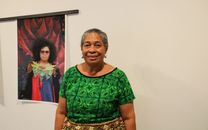
TALES OF TIME: Passing Down The Art of Tongan Tapa
“My mother, she make anything. She make ngatu (tapa cloth), she weave…" “When I was a young girl, I grow up watching my mother and that is how I learned. Just by watching her.” 65 year old Sulieti Fiemea-Burrows tells the story of how she first began her craft in the village of Falevai. A small community in the Vava’u islands of Tonga, with a name that literally translates in English to ‘water house’ - a telling of how the seas and oceans surround its homes. In Falevai, her curiosity and eagerness drew her hands to a craft which is now, no longer practised in the village. “I follow around my mother,” explained Sulieti “Everytime she do something - sitting over there by the tutua (wooden block) with ike (hammer-like object) and doing tapa. I sit by her and do my little stuff too.” Making Tapa Cloth, British Museum For Sulieti’s mother, her work provided an income for the family and was often exchanged for food. “Yes, that’s strange enough that she don’t like me to use the stuff that she use!” said Sulieti laughing. “She wants me to just go and get the off-cuts for me to use it because she told me I’ll waste it. So I get the off-cut and that’s the way I use to do the work.” After meeting her Kiwi husband in Tonga’s capital, Nuku’alofa, in 1978 and then moving to New Zealand, Sulieti explained she often thought about ‘home’. Her husband sent $10 NZD to Tonga every week to help her mother and Sulieti wanted to help him. “That’s where I start to try to make tapa and take to the flea market to sell.” Sulieti Fieme'a-Burrows, her daughter Tui Emma Gillies and her grandaughter Heilala. “I do some sewing and take over there. Anything I can make, I take with me to the market to sell and send up some money to my mum.” And in the same way her mother Ema Topeni, perhaps accidentally, passed on the family craft, Sulieti did the same for her daughter Tui Ema Gillies. “When she was two years old I can see her sitting over there, she will get a little cut piece of tapa and she play with it,” she said “And when she’s three years old she’s coming along with me to the market. And then she grow up and she’s over there selling her stuff.” Now 36 year old Tui is a professional Tapa-cloth artist herself and is helping to revive what has become a dying art-form in Tonga. “I’m very proud because I can see my daughter, she continue what I’m doing and what my mum was doing,” said Sulieti “She follow my footsteps. And I’m hoping that my little granddaughter will follow.” Tui's daughter Aroha Heilala Gillies, learning how to beat tapa cloth at her Tongan preschool, Akoteu Kato Kakala, in Otara. Tui explained that the art form, which is now no longer practised in her mother’s village of Falevai, is dear to her. “I actually grew up in a bedroom where my whole room was covered in my grandmother’s tapa cloth,” she said “She had made all this tapa - it was like a healing cloth and very warm. It was like a tapa womb.” Print from Tui's bedroom wallpaper growing up, the Ngatu painted by her grandmother Ema Topeni. Last year they returned to Falevai to work with local women in creating two large Tapa pieces. The process of making tapa is long and rigorous, which adds to its value. It is made from the bark of the mulberry tree or tutu which is soaked in water overnight, Its strips are then beaten over a tutua with a ike until they become wider and longer. Once dried, the pieces are joined using a paste made out of manioke (tapioca) flour, or potato starch. Women in Falevai rubbing the tapa cloth. “There are no mulberry trees growing over in Falevai, so we purchased the tapa cloth at Nuku’alofa in the market and we took it over by plane and put it together with the women,” explained Tui. The process of stitching the kupesi together involves all the women coming together in what is called a koko’anga - this is where many young girls learned the craft by watching their mothers, aunties and grandmothers. “It was the first time they had received money for any of the work they had done,” said Tui of the women of Falevai. “We were very lucky because we had Creative NZ - they provided to be able to pay the women as well.” “It was quite empowering.” After their six-by-four meter long tapa cloth had been put together, Tui and her mother returned back to New Zealand to paint it. Once tapa cloth is painted over and dyed, it is then called ‘ngatu’. Ngatu is one of Tonga’s most treasured possessions and each design contains cultural value and significance. Tui's innovative designs have taken a turn from tradition and for the first time include coloured pictures of village life, never before seen on traditional Tongan tapa cloth. “Sometimes mum would worry a little bit and say ‘oh well, you can do it because I’m doing it with you but oh you know, some of the people, they might get mad.’” Tui's mark on the art reflects her own inspirations and where she comes from. “Auckland is like a big melting pot of cultures,” she said “There are so many cultures, there’s so much colour and the the polynesians - they love colour!” “It’s about time we start adding colour!” As a modern contemporary artist, Tui says tapa is an amazing art to draw from. One of her latest pieces, titled ‘Fefine’ depicts a daring and provocative empowerment of women. 'Fefine' by Tui Emma Gillies “We’re powerful. We can do so much,” she said “I really wanted to touch people but I also really wanted to challenge people - because when you look at it, it makes you think.” Now Tui and her mother Sulieti have traveled to various parts of the world, sharing the beauty of Tongan heritage through their artwork. Tui says she loves learning from her mother and describes Sulieti as a perfectionist. “Naturally when you’re together all the time you get frustrated at each other (laughs) but it’s awesome and it helps me stay in touch with my Tongan roots.” Tui describes her mother’s work as strong and long-lasting, and refers to a baby bassinet that Sulieti had made years ago in Tonga. “Before we move to New Zealand, I carried my son and I sit every night and weave the bassinet of my baby,” explained Sulieti. The bassinet is made out of natural Tongan plant fibres, tu’a niu and lou’akau, and is nearly 40 years old. It has since been passed down and given new life in the bedroom of Tui’s children, as a light shade. “It’s still in amazing condition,” said Tui “Nothing’s come off. We could probably dust up the top but that’s it.” Their schedule over the past year has included a presentation at Vienna University in Austria and speaking at a conference in Madrid as well as the National Gallery of Victoria in Melbourne. While in Madrid, Grassi Museum in Germany requested to buy a kupesi (print block) Sulieti and Tui had made to add to a collection of items they had from Vava’u. “We were a little bit hesitant with departing with it,” said Tui “But then we thought, yes we should do it because it would be looked after over there and it’s part of spreading our work around the world.” Madrid also presented a life-changing experience for both Mother and Daughter artists when they were given the chance to see the notorius Malaspina carpet - the oldest intact Ngatu from Tonga that has been kept anywhere in the world. “Let’s just say that when we saw the ngatu there was something about it. I burst out crying.” expressed Tui The Malaspina Ngatu Ta‘uli is around 225 years old and had been kept safe and hidden for nearly 200 years. The majestic carpet is 30 feet long and was acquired by the noble Spanish-Italian explorer Alessandro Malaspina during a visit to Tonga. “We can only see a part of it - because they couldn’t pull it out it’s so long,” “There are big possibilities that it’s from Vava’u,” claimed Tui excitedly. “We were told that Malaspina had come from Spain and celebrated for two weeks over in Falevai.” The visit to Malaspina’s carpet was an emotional one for both women, having touched and experienced the oldest known example of the art form they are working hard to keep alive. Close up of the Malaspina Ngatu Ta'uli Every art piece unravels stories that are settled within the ink and woven into every fibre of fabric. The fibres of the 'Malaspina Ngatu Ta'uli' whisper their own stories and and so too does the tapa of the ‘Falevai Flava’ piece crafted by the women of Falevai, including Sulieti and Tui. But the most powerful thing to note about Ngatu in many parts of the pacific is that it’s not the type of art you purchase to keep on display, as is most commonly seen in other parts of the world. In Tongan families, Ngatu is considered koloa, meaning treasure. They are treasures given to honour people during weddings and funerals and other significant events. They celebrate the milestones of life and are in essence, the culture of Tonga pieced together. “It’s designed to be passed over all the time,” explains Sulieti “Our tapa is a part of us, to give.” By Indira Stewart Photo credit: J.L McCreedy/www.TongaTime.com Cover image photo credit: Radio New Zealand
-
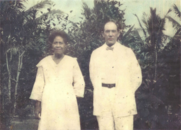
TALES OF TIME: Williams Family
Gina Williams writes about her family history and the many nations that make up her heritage. “Where are you from?” Growing up in a multicultural school in central Auckland, it was always interesting finding out where each other was “from”. Too boring to simply say I was born in New Zealand, instead my response was “England, Ireland, Scotland, Sweden, South Africa and Samoa”. My overconfident 9-year-old self loved the oohs and aahs from the other kids, and if I held anyone’s attention for long enough, I’d tell them that my Samoan Nana was actually born and raised in Rarotonga. Aulola Williams-Fotu, Gina Williams, Leon and Gianni Williams-Fotu. As I got older, my response shortened to “I’m part Samoan”. It seemed almost too indulgent to claim all of those nations as my own, but the truth is, my heritage is in fact that colourful and diverse and full of tales of high adventure. Now that I’m in my thirties (ticket to not care about what anyone thinks), I’m going to indulge in my cultural identity. So there. Mele Mataele - (Photo supplied by Peter Jensen) Mele Mataele, my great, great grandmother was born in Samoa. There is a bit of mystery around Mama Mele, with different opinions from around the village (Lefaga), but what we believe is that at age fourteen she left Samoa for Tonga as part of a dance troupe. In Tonga, she met Englishman Ernest Hamilton Rea Mitchell who was born in Liverpool in 1868. At 19 Ernest travelled to New Zealand from England with his widowed mother Sarah (nee Rea) and five siblings in 1887. A year later he went to Tonga for reasons unknown. Mele Mataele & Ernest Mitchell - (Photo supplied by Carol de Jager-Taripo) Mele never returned to her homeland of Samoa and she and Papa Mitchell married on October 31, 1891 in Vava’u, Tonga. I wonder how they communicated - did they pick up Tongan? Or did they just speak the language of love? ;-) They communicated somehow because they had eight children; four girls and four boys. Their third child Agnes was born in Ha’apai, Tonga, on January 29, 1897. She was to become my great grandmother. The Mitchell family island-hopped to Rarotonga as Papa Mitchell set up a business as a trader. As Agnes was happily growing up in Rarotonga, in a far away land was Cecil John Bouchier. He was born in Capetown, South Africa in 1900 to an Irishman Thomas Bouchier and Maria Agnes Mulvihal. Cecil fought in WW1 as a gunner. After the war, he worked as an agricultural scientist and early in the 1920s, he accepted a post in Jamaica and set out to sail to the Bahamas. For reasons which are obscure, he never got there and instead settled in Rarotonga where he met his love, Agnes. Agnes Bouchier. Agnes and Cecil had six girls all born in Rarotonga. The eldest, Eileen, would be my nana. The Bouchier family had been living a comfortable life in the Cook Islands with my great grandfather scoring a good salary as second-in-charge at the Agriculture and Fisheries Department when tragedy struck. In 1935, Cecil, aged only 35, was swept from his waterfront office by a tidal wave. His leg was badly damaged and eventually amputated, but while he was waiting for a boat to New Zealand for treatment, gangrene set in and he died. Now a widow with six daughters to bring up on her own, Agnes and the girls, my nana Eileen the eldest at age 12 and her youngest sister only 2, moved to New Zealand in 1936 and settled in Grey Lynn - within a mile of where I live with my family today. Agnes Bouchier and her daughters, Nana Eileen far right. In later life, Agnes’ mother, Mama Mele too left Rarotonga and came to live in New Zealand after Papa Mitchell died. She died in 1949 in Auckland and her ashes were held at Purewa Cemetery in Meadowbank until recently...but more about that later. A few years after arriving in New Zealand, my Nana Eileen met my grandfather, Arthur Williams, who was born in Apia, Samoa. He was one of five children to Arthur Williams senior, an Australian who ran away from home as a teenager and made his way to Fiji where he became a chauffeur for the Government and drove the premier around in the country’s first Rolls Royce. In 1915, Arthur Williams Senior visited Samoa as a singer in a concert party and liked it so much that he stayed and married Telesia Tuala of Leulumoega and Saleaula (originally and then after devastating volcanic eruptions, the people relocated to Leauva’a). Telesia’s father, Tuala Silivelio, had established the Catholic mission in Savai’i. Arthur Williams Snr & Telesia. When the Second World War broke out, Arthur Williams Senior, or Viliamu Faipaipa as he became known in Samoa, sent my grandfather Arthur Jr, then 17, to enlist in the war effort. As his yacht the Satenella approached the Auckland heads, it was shot at repeatedly when the captain failed to identify himself. After being kept under house arrest until the authorities were satisfied the visit was a peaceful one, my poppa found work as a labourer within 24 hours of arriving in New Zealand. He nearly fainted when he got his first pay packet because he was paid in a day what he earned in a month in Apia. Nana Eileen and Poppa Arthur got engaged and married soon after they met. Poppa Arthur enlisted and went to Guadalcanal as a plumber. For a couple of years after the war they lived in Apia but came back to Auckland where they had their third son and my dad, Bryan, in 1950. They went on to have a fourth child, a daughter, my Aunty Lorraine who after training as a teacher in New Zealand, moved to Samoa in the early 80s and has lived there ever since. Eileen Bouchier & Arthur Williams Jnr. My dad Bryan met my mum Lesley Ensor of Swedish, Scottish and English descent as a teenager in Moerewa, in the north of New Zealand. They married in Auckland in 1973 and had four children. I am the youngest, and I have three crazy, beautiful children; two sons and a daughter to a NZ-born Tongan from the villages of Sopu and Folaha. Recently, some family members decided Mama Mele’s ashes should be in Rarotonga. And so it was to be. This year in October she was finally laid to rest with her husband in Avarua on the same weekend that they had been married 125 years earlier. Back together again in a grave for eternity, their grave was adorned with five flags of the different nations relating to their life journey - United Kingdom, New Zealand, Samoa, Tonga and the Cook Islands. Unveiling in Raro 2016 - (Photo supplied by Chunillal Pema) When I fill in official documents for my children, under the “ethnicity” section I always tick three boxes: NZ/European, Samoan and Tongan. But our heritage is so much more than that. When I can hold their attention for long enough, I will tell them our rich family history and hope that they don’t wait until they are over 30 to indulge in it too. Paul, Gina, Lesley, Bryan, Marie Young & Gavin Williams.
-
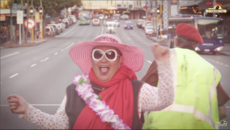
Tales of Time: Coconut Grove in K'Rd
Karangahape Road (K'Rd) was Auckland's 'shopping street' from the 1880's through to the late 1980's. But, from the 1960's on it held a special place for Pacific Islanders living in Auckland at the time, especially on Thursday late night shopping nights when the street came alive with colourful island wear and families doing everything from food shopping to buying school uniforms. Many islanders growing up in the city at that time have fond memories of the street that they called 'Coconut Grove' because of the number of islanders you could find there. The height of this phenomenon was during the 1980's but with the advent of malls, a population ever moving out from the city and other changes seen during the 1990's, Coconut Grove was soon diminished - but not forgotten! The new Coconut Grove event (organised by the Waiata Artists Trust & the Polynesian Panthers) is part of K'Rd's revitalisation and celebratory programme called 'First Thursdays', which happens on the first Thursday of each month where the street takes on a carnival type atmosphere.
-
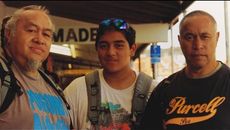
TALES OF TIME Islanders in Ponsonby
Islanders in Ponsonby & Grey Lynn Ponsonby and Grey Lynn were significant areas where Polynesians from the islands would settle from the 1940's onwards. For 13 years the Pua brothers, Reverend Mua Strickson-Pua and Sofi Ulugia-Pua have told their story in historic walks through Ponsonby and Grey Lynn. We joined them as they take Sofi's son Iosefa Ulugia-Pua on one of those walks particularly talking about growing up in 'the hood' during the 70's and 80's.
-
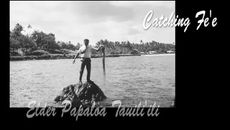
TALES OF TIME: Samoa 1970 - 1972 Pt3
The photo archive of Mormon Elder Tomasi who took some beautiful photo records of Samoa in the 70's told here in 3 parts #TalesOf Time Part 3 showcases scenic shots in Pago Pago (American Samoa), villages in Upolu and again daily life in Samoa.
-
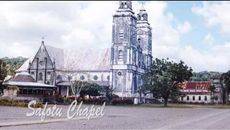
TALES OF TIME: Samoa 1970 - 1972 Pt2
The photo archive of Mormon Elder Tomasi who took some beautiful photo records of Samoa in the early 70's told here in 3 parts #TalesOf Time Part 2 showcases shots from villages in American Samoa, villages in both Upolu & Savai'i, Robert Louis Stevenson Museum, the old airstrips and more.
-

TALES OF TIME: Samoa 1970 - 1972 Pt1
The photo archive of Mormon Elder Tomasi who took some beautiful photo records of Samoa in the early 70's told here in 3 parts #TalesOf Time Part 1 showcases Samoa's beautiful beaches, sunsets & children, daily life in Samoa as well as popular spots - Papase'ea Sliding Rocks, Luatuanu'u falls and more.
-
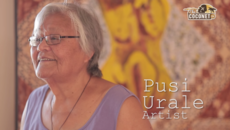
TALES OF TIME: Pusi Urale
Pusi Urale has always wanted to be an artist - and fondly recalls growing up in Samoa and moving to New Zealand for a better life for her and her family. Now in her late seventies, Pusi is a well-known NZ artist, and her children have grown up to be some of the big movers and shakers in the Arts here in New Zealand. SUGGESTED LINKS Inked - Maila Urale Tautai Navigate 30 Years of Pacific Art
-
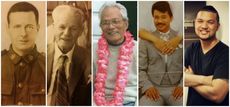
Tales Of Time - Bourke Family Tree
The men of the Bourke Family, as told by Puleleki Jackson-Bourke - JOHN BOURKE Great, Great Grandfather (Picture 1) Was born 1875 in England with an Irish father (Jack John Bourke) and and English mother (Elizabeth Moran). John Bourke and his mother migrated to Australia and sometime before 1903 he made his way to Tonga where he worked as a carpenter. He met my Great Great Grandmother Ana Fakaola from Ha'apai and together they had 5 children. John Bourke travelled to NZ and joined the NZ army. From there he travelled to Samoa in 1918 with the NZ expeditionary force. Whilst John was In Samoa he changed his last name to BURKE and remarried Sivai Timoti. Together they began the BURKE line in Samoa with 5 children. John Burke died in Samoa and was burried in Tufuiopa. - TOMASI TUPOUNIUA BOURKE Great Grandfather (Picture 2) Was born in 1903 and was the only son of John and Ana's 5 children. Tomasi left Ha'apai and married my Great Grandmother Vileti Latuvao Afu from Vava'u. They had 9 children together. Out of those 9 children my Grandfather Siaki was the second eldest. Siaki is the Tongan translation for the name Jack - It is likely that this was a reference to John Bourkes father. (Traditionally the naming of the eldest child, was a privilege for the Father’s side of the family, as per the Tongan culture.) - SIAKI STANISLAUS BOURKE Grandfather (Picture 3) Siaki was the second eldest of Tomasi and Vileti's children. Siaki in his younger days had met a lovely Niuean girl by the name of Langimaina Sionetali who was stranded at the wharf in Tonga. She had missed her boat back to Niue and so Siaki approached her and offered her a place to stay, without hesitation he proposed to her and she refused. Langi requested that Siaki shave his beard and cut his long hair, and if he did she would marry him. Siaki returned at a later time, clean shaven, tall and handsome. They eventually married and moved to Hakupu, Niue Island before mirgrating to New Zealand. Together they had 6 children. - TOMASI BOURKE Father (Picture 4) Tomasi was born in Neiafu, Vava'u Tonga. He is the eldest of Langi and Siaki's bilogical children. Tomasi migrated with his parents and siblings to Auckland, New Zealand in the 1970's. He worked at Pacific Steel and married the love of his life Joyce May Jackson (Half Niuean/Half Samoan) from Hakupu, Niue island.
